Integrating culture and curriculum

Cross-curricular projects bringing meaning to our place in the world
A hub for learning history where it happened
Early learning thrives with international teachers
Cross-curricular approach to Matariki in Te Waipounamu
28 AUGUST 2023 | VOL. 102 | NO. 11

Māori Language Week 11-17 September 2023 Te Wiki o te Reo Māori 11-17 o Hepetema 2023
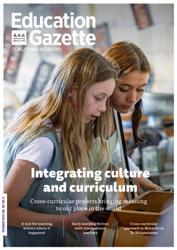

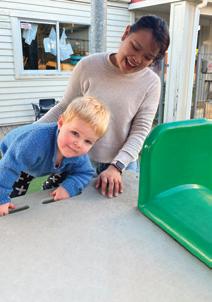
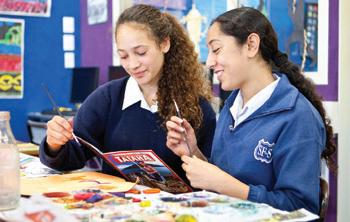
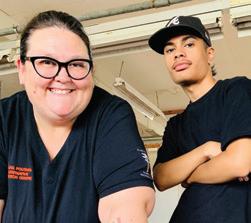
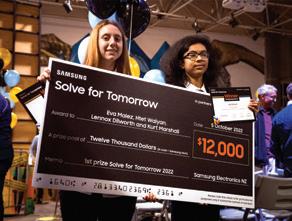
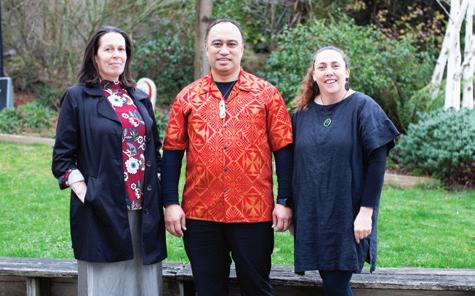
1 Tukutuku Kōrero 28 August 2023 4 A hub for learning history where it happened 10 Early learning thrives with international teachers 14 Growing great specialists in gifted education 18 Collaboration key to transforming lives of rangatahi through EdTech 24 Future-focused ākonga STEAM ahead with national challenge 28 Books connect ākonga to past, present and future 34 Cross-curricular approach to Matariki in Te Waipounamu 40 Electrifying cross-curricular education 44 Former cold storage supplier builds warm classrooms 46 Re-thinking school events to lift engagement Page 4. Ākonga interact with history at Totara Estate in Oamaru, which is idenitified as a Tohu Whenua heritage site. Tohu Whenua are the places that have shaped Aotearoa New Zealand. Read more about a new education hub making it easier for teachers to find experiences at places that tell our nation’s defining stories.
Josh Jenkins. ISSUE 102.11 Contents 4 14 10 18 24 34
Photo:
Scan
PUBLISHED BY
Education Gazette is published for the Ministry of Education by NZME. Educational Media Ltd. PO Box 200, Wellington.
ISSN 2815-8415 (Print)
ISSN 2815-8423 (Online)
All advertising is subject to advertisers agreeing to NZME. Advertising terms and conditions www.nzme.co.nz/ media/1522/nzme-advertisingterms-sept-2020.pdf
EDUCATION GAZETTE ONLINE
Read: Model to underpin teaching and learning for literacy & communication and maths
The Common Practice Model will provide greater clarity and direction for teaching literacy, communication and maths. It outlines the evidence-informed principles, pedagogical approaches and practices for teaching these skills which are relevant for learning in Aotearoa New Zealand.
Listen: Revisit Education Gazette podcasts
We have lots of new podcasts coming out towards the end of this year, and hope to make it a regular feature with every print edition in 2024. Listen to our previous podcasts and let us know what you would like more of! Email gazette@education.govt.nz with feedback.
Read: A new beginning at the Rangitāne Symposium
In June, more than 400 kaiako and learning coaches within the Palmerston North East Kāhui Ako came together to strengthen and develop their understanding of the history and knowledge of the area and iwi.
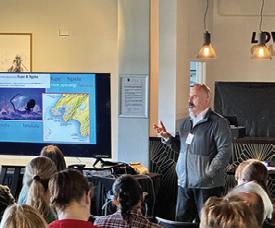
STORY IDEAS
We welcome your story ideas. Please email a brief (50-100 words) outline to: gazette@education.govt.nz
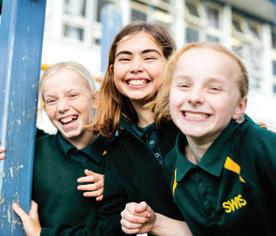
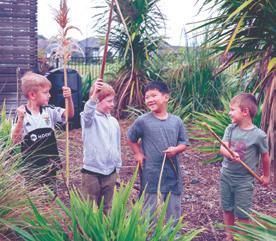
SUBSCRIPTIONS
eleni.hilder@nzme.co.nz
VIEW US ONLINE Web: gazette.education.govt.nz
Instagram: @edgazettenz Youtube: youtube.com/ edgazettenewzealand
PLD
KEY CONTACTS
Reporter gazette@education.govt.nz
Display & paid advertising
Jill Parker 027 212 9277 jill.parker@nzme.co.nz
Vacancies & notices listings
Eleni Hilder 04 915 9796 vacancies@edgazette.govt.nz notices@edgazette.govt.nz
DEADLINES
The deadline for display advertising to be printed in the 18 September 2023 edition of Education Gazette is 4pm on Friday 1 September 2023.
VACANCIES NOTICES
the PLD,
listings and
at gazette.education.govt.nz
To view
general notice
vacancies
the QR codes with the camera on your device. 2 Education Gazette gazette.education.govt.nz This publication is produced using FSC® Certified paper from Responsible Sources.
Everything is connected
Tuia ki te Rangi
Tuia ki te whenua
Tui ki te moana
Tuia ki te herenga tāngata
Ka rongo te pō
Ka rongo te ao.
This whakataukī, as explained by Ngā Pātaka Kōrero o Te Arawa, reminds us that “everything is connected from Ranginui (Sky father), to Papatuānuku (Earth mother), to the moana (lakes, rivers, oceans), to te herenga tāngata (people) and all exists in harmony”.
Cross-curricular learning supports the idea that everything is connected, and where ākonga make these connections, the mātauranga is more meaningful and relevant to their world.
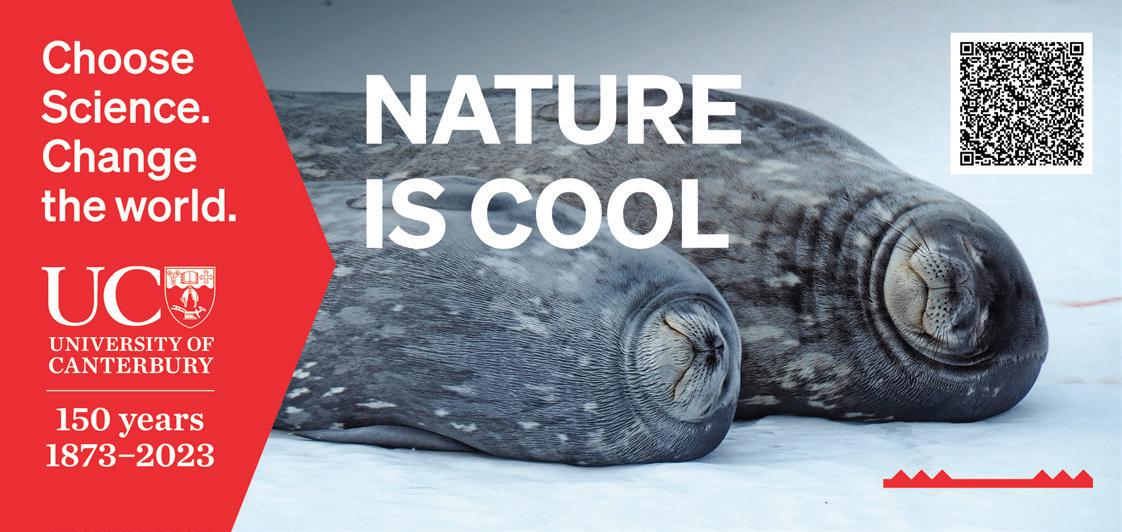
Curriculum integration is often linked with inquiry or project-based learning in which ākonga extend and blend their understanding of literacy, maths, science, the arts, technology, languages, music and more, but also develop the necessary skills and attributes to find solutions to real-world problems and become life-long learners.
Read about a nationwide challenge asking secondary school students to develop solutions to existing problems using STEAM learning areas; education technology transforming learning and equipping ākonga with skills for the future; and two Nelson kaiako using resource kits to electrify cross-curricular education with a science focus.
We also explore cross-curricular learning projects that reflect local context and cultures, and help ākonga understand who we are as peoples, their place in Aotearoa, and our place in the world. Read about a new education hub unlocking experiences at places that tell our nation’s defining stories; two South Island schools bringing Matariki to light with project-based cross-curricular learning; and a series of new
books and pūrākau connecting ākonga to the past, present and future within Aotearoa New Zealand’s histories and Te Takanga o te Wā.

I am also thrilled to introduce Mikayla Morris, the newest member of the Education Gazette team, who will play a key part in elevating our digital content, including podcasts, videos, webinars, and online articles. With her experience in radio, Mikayla is excited to be bringing many of your stories to life through rich audio experiences that compliment your busy lives.
For now, enjoy the rich storytelling throughout this edition, written by journalists across the motu.
EDITOR’S NOTE
3 Tukutuku Kōrero 28 August 2023
Kia pai te rā, nā Sarah Wilson Ētita | Editor
Mikayla Morris interviews Albany Heperona Peseta and Faith Leipapati-Saimoa Taula from Tagata Mai Saute Academy in Ōtautahi Christchurch. Keep an ear out on educationgazette.podbean.com to hear how they are connecting Pacific learners to their roots through traditional song and dance.
A hub for learning history where it happened
A new education hub on the Tohu Whenua website makes it easier for teachers to find experiences at places that tell our nation’s defining stories.
Curriculum-linked information about places recognised as Tohu Whenua is organised into appropriate year groups, ensuring it is targeted at the right level for learners. The layout follows the ‘Understand, Know, Do’ framework, aligning it with the Aotearoa New Zealand’s histories curriculum.

4 Education Gazette gazette.education.govt.nz
HISTORIES
Ākonga explore the Kawarau Suspension Bridge.
Photo: Clare Toia-Bailey.
“This is a great starting point when unit planning using the Aotearoa New Zealand’s histories curriculum or when connecting content to place,” says Hannah Scott, social sciences teacher at Wellington East Girls’ College.
She’s looking at the new education hub on the website of Tohu Whenua, a government initiative aimed at connecting New Zealanders with our nation’s unique heritage places.
Caroline Toplis is pleased with the feedback. As Tohu Whenua programme manager, she and her team have worked hard to make it as easy as possible for teachers to find the places that tell Aotearoa New Zealand’s defining stories.
“We offer a one-stop hub for teachers looking for experiences at significant historical and cultural places that connect to the curriculum.
“All Tohu Whenua places tell defining stories of our regions and our country; they are places where ākonga can learn about and experience history where it happened. If teachers are looking for places that bring to life themes in the curriculum, often in their own backyard, Tohu Whenua is a good place to start.”
Variety of storytelling
Tohu Whenua places have been selected in part for their high quality, on-site storytelling of nationally significant events and themes. Between them there is great variety. Examples include landscape-based stories important to mana whenua; places where there was conflict over abuses of Te Tiriti o Waitangi; the site of our deadliest mining disaster and the birth of unionism; the development of technologies that made us world leaders in farming – and so much more.
“To make it as easy as possible, we provide downloadable documents that connect year-levelappropriate themes in the curriculum with Tohu Whenua places,” says Caroline.
Kate Coughlan, Year 3 teacher at Te Kura o Papakōwhai
Papakōwhai School in Porirua is impressed by the material provided, saying “it makes teaching about historical sites easy” particularly because it is organised by year group and follows the framework of the curriculum.
“I cannot wait to use these resources [to create lesson plans for] my classroom.”
On-site experiences
The Tohu Whenua website then goes a step further.
As Caroline explains, “Almost all Tohu Whenua provide unique opportunities to do a class visit, so we’ve provided links for teachers to get in touch with experienced educators and tour guides who can bring the stories of these places to life for their ākonga, through interactive, hands-on learning at place and sometimes even virtually.”
Opportunities include Enriching Local Curriculum educators who provide support before, during and after a site experience; tours provided by local guides that can be shaped to suit the needs of a class; up-to-date resources, and accommodation opportunities for camps.
Tohu Whenua currently recognises 26 important heritage places in Te Tai Tokerau Northland, Te Tai Poutini West Coast, and Otago – with the aim to expand into other regions.
As Hannah points out, “I think [the Tohu Whenua website] can be really useful even if these sites are not in your area and you can’t travel to them.
“Often when teaching a class you will have students who have ties to places not in your area, and making connections to places all over the motu can be really meaningful for those students.”
Supported by local history experts
Ākonga are much more engaged when taken out of their classroom environment, says Hannah.
“It’s very hands-on, they can physically see and touch things, and get a real sense of it. It inspires them and opens their eyes to what is out there.”
5 Tukutuku Kōrero 28 August 2023
“We’ve provided links for teachers to get in touch with experienced educators and tour guides who can bring the stories of these places to life for their ākonga, through interactive, hands-on learning at place and sometimes even virtually.”
Caroline Toplis
Amanda Viana can’t help getting excited about placebased heritage learning.
She leads a Ministry of Education-funded Enriching Local Curriculum programme in historic Arrowtown, which is recognised as one of 11 Tohu Whenua landmarks in Otago, focusing on Te Tiriti o Waitangi and the stories and histories of settlers.
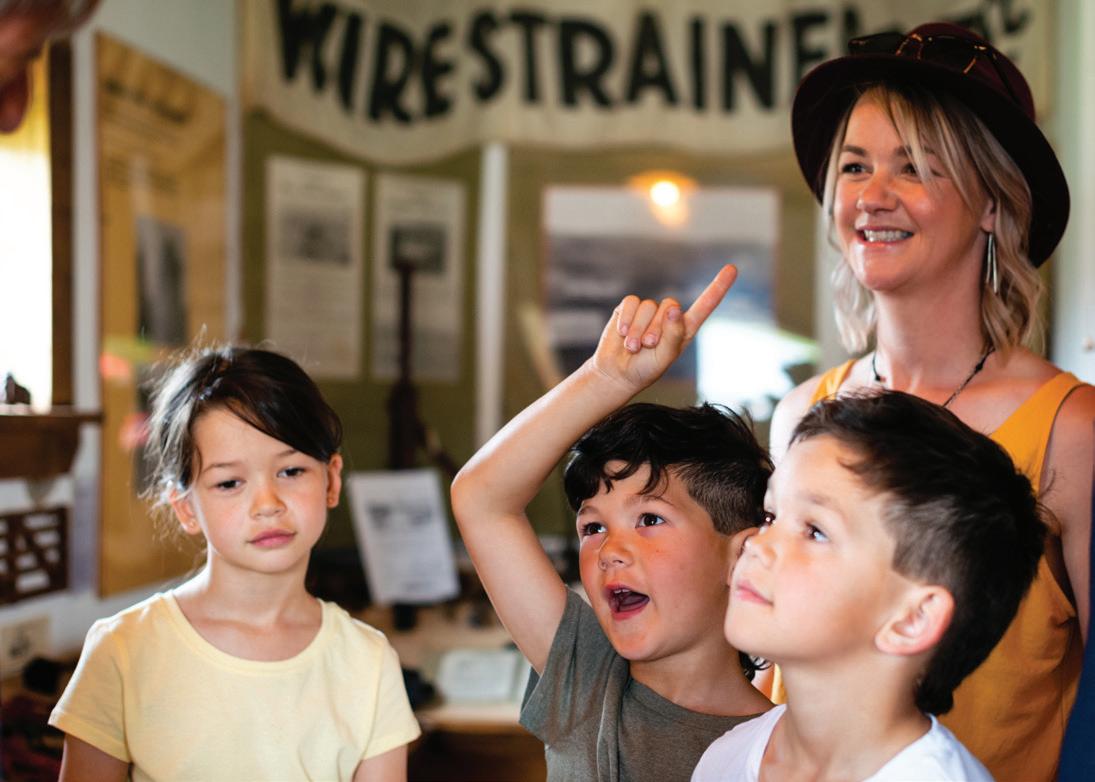
Last year Amanda and her team taught over 4,100 students from about 115 different schools from preschool level to Year 13; she has seen first-hand how ākonga thrive when learning about heritage at place.
“It’s good for teachers because they can just turn up,” says Amanda.
“We provide pre- and post-visit resources, and qualified educators who facilitate the activities and learning.
“We’re based at the Lakes District Museum which is located in the historic BNZ building, and everything is within walking distance – the old gaol, Chinese settlement, churches, cemetery, even the river where we can pan for gold.”
Amanda says they are in a perfect location to support teachers with many different themes.
“For example, the restored Chinese gold miners’ settlement tells the stories of immigration, discrimination,
racism and how that led to Chinese having to pay poll tax. But Arrowtown also tells the stories of perseverance, hardships and sacrifices – from multiple perspectives.
“Here we can have conversations about New Zealandwide issues and show how the gold rush in Arrowtown helped build the economy of Dunedin and New Zealand as a whole.”
Broadened awareness
Although Lakes District Museum does its own promotion, Amanda sees the benefits of being a part of the Tohu Whenua education hub.
“We’re very happy that Tohu Whenua helps us increase our awareness of historic Arrowtown being a very special place – and highlights opportunities such as ours in other parts of the country.”
Two other Enriching Local Curriculum programmes provide learning opportunities at Tohu Whenua, including at the Waitangi Treaty Grounds where students are encouraged to engage first-hand with the history of Aotearoa New Zealand.
The other is the Marsden Valley Education Centre, which provides learning opportunities at several Tohu Whenua heritage places on Te Tai Poutini West Coast, including
6 Education Gazette gazette.education.govt.nz
Left and middle: Learning is brought to life at Hayes Engineering Works and Homestead in Otago.
Photo: Clare Toia-Bailey.
Reefton, Waiuta, Brunner Mine and Denniston Mine.
Guided tours tailored to the needs of ākonga can also be provided at several other Tohu Whenua landmarks, including those owned and operated by Heritage New Zealand Pouhere Taonga.
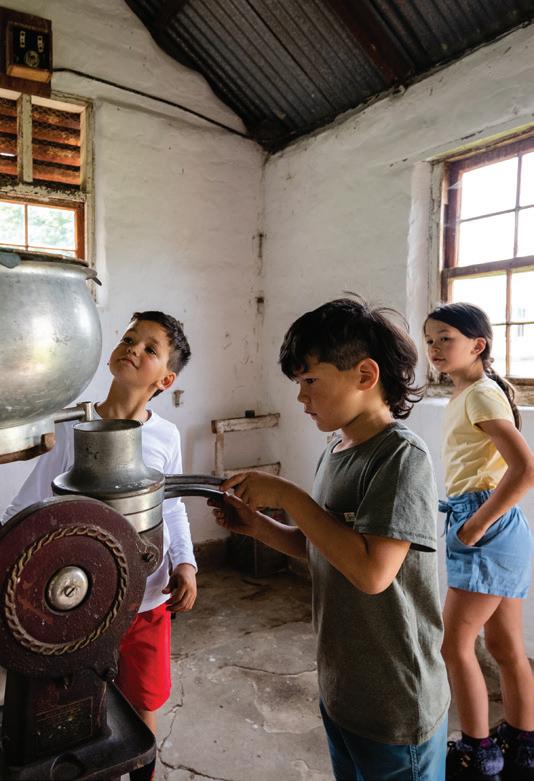
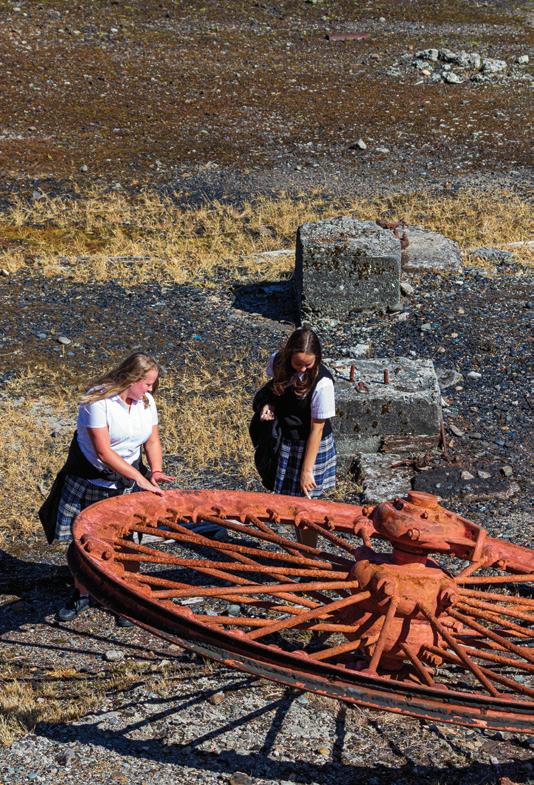
Examples include Pompallier Mission and Printery in Kororāreka Russell (our only surviving pioneer printery and tannery) and Totara Estate near Ōamaru (the birthplace of our billion-dollar meat export industry).
To see what programmes or opportunities are offered, teachers can simply click on the ‘School visits’ section of the Tohu Whenua webpage that relates to the specific site they are interested in.
Turangawaewae
Lisa Foggin, a SENCo and specialist teacher at Alexandra Primary School, sums up the benefits of learning local history where it happened.
“It’s great for ākonga to have a connection to their turangawaewae, strengthen their sense of connection to place and each other.”
What is Enriching Local Curriculum?
Enriching Local Curriculum (ELC) – formerly known as Learning Experiences Outside the Classroom (LEOTC) –supports community organisations to draw on localresources and expertise, to provide our tamariki with authentic, hands-on/minds-on learning experiences that complements curriculum.
Providers work in partnership to run educational programmes for ākonga in early learning services (0-6 years of age), state and integrated schools and kura, and registered private schools in Years 1–13. ELC programmes are not divided into subject areas. Rather, they are experiences that support broad curriculum outcomes.
ELC programmes have meaningful bicultural partnerships with key mana whenua knowledge holders, to improve educational outcomes.
Read more at eotc.tki.org.nz.
7 Tukutuku Kōrero 28 August 2023
Ākonga at Denniston Mine.
Photo: Jason Blair.
Rail Tales
Rail Tales is a great example of an interactive resource all about a special Tohu
Recognised by Tohu Whenua as one of our nation’s most treasured heritage places, the Otago Central Rail Trail deserves a special mention.
That’s because of the highly interactive Rail Tales website and lesson plans developed by technology education specialist Anthony Breese of Museograph – specifically as a teaching resource from primary through to NCEA Level 3.
Principals and teachers rate the resource as excellent.
“There’s a lot in it,” says David Grant, principal of Big Rock Primary School in Dunedin, who found the Rail Tales website through Tohu Whenua.
“You could use it without going on the trail itself.” But he is quick to add, “we do cycle a part of the Otago Central Rail Trail each year. A big theme has been resilience, now we have this resource to link in history as well.”
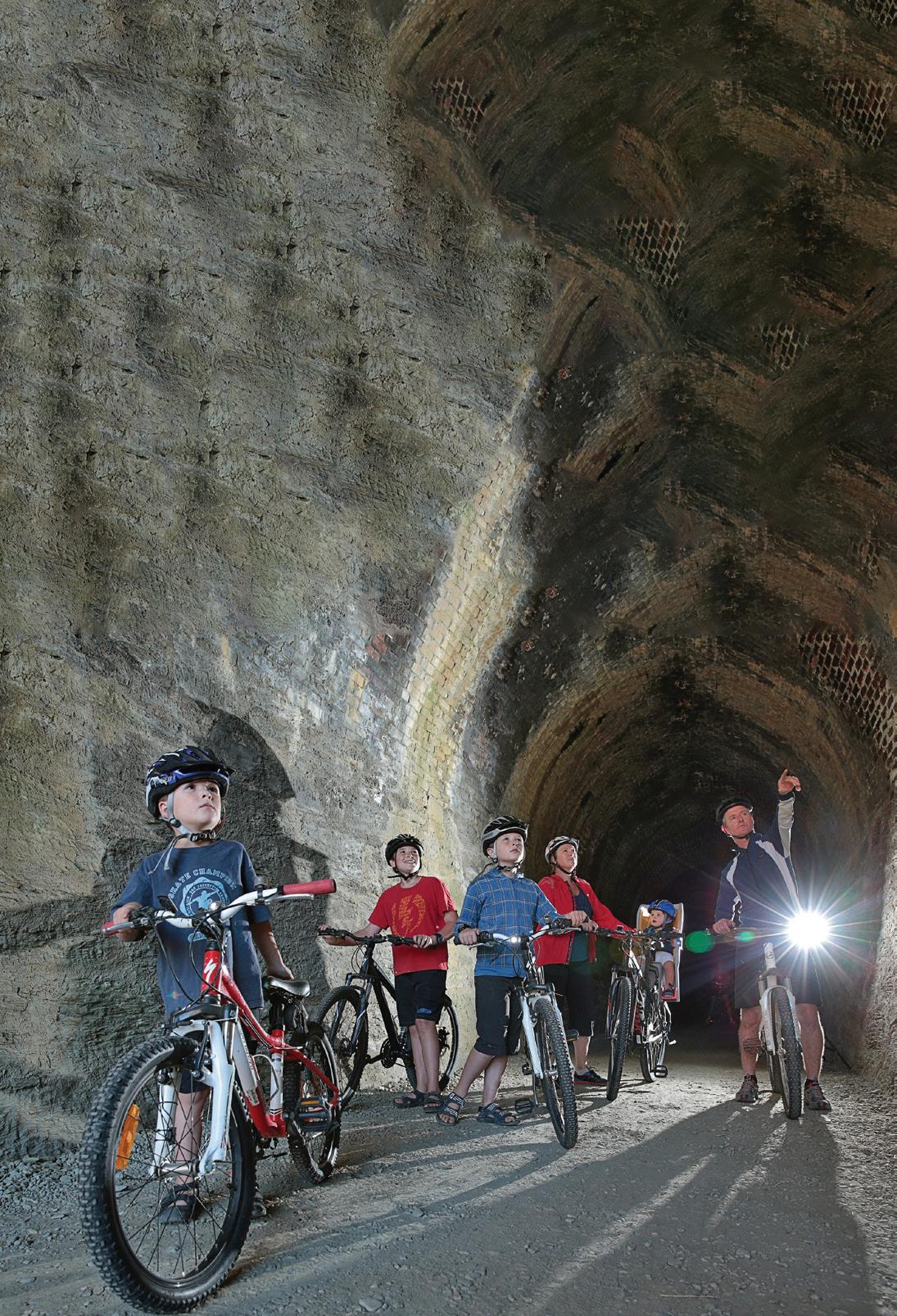
David is particularly excited about finding his ākonga learning about “super modern technology imported from around the world going into really remote places –materials to build the railway and the towns it serviced”. He also points out the link to the Dunedin Railway Station (also recognised as a Tohu Whenua).
“A spectacular building which had an incredible amount of resources put into it considering that Dunedin only had a population of 50,000 at the time.”
Lexie Hay from Alexandra Primary School, who tested a prototype of the resource, agrees.
She says, “All the information that was scattered across various websites is now located in one place. My kids love following along the trail and clicking on the yellow icons.”
Last year, Lexie’s Year 6 class focused on the history on the Otago Central Rail Trail, in particular the early days of Hyde and the Hyde Railway crash, “which is New Zealand’s second worst rail disaster.”
She and her class cycled parts of the Rail Trail, visiting old railway stations, a turntable and museum. Her kāhui ako then created 3D models of the Otago Central Rail Trail –their maths focus was on the coordinates, and they created QR codes which linked to a speech competition where the children reported something special about each location.
Teachers and kaiako interested in the history of Otago can also use resources from Tūhura Otago Museum. The Museum’s Education Team presents a wide range of hands-on ELC education programmes. Read more at otagomuseum.nz/learn.
8 Education Gazette gazette.education.govt.nz
The Otago Central Rail Trail. Photo: James Jubb.
Whenua.
KI TE ANAMATA!
TE AHO TĀTAIRANGI
Tauawhitia a tātau tamariki, mokopuna kia tū rangatira ai i te kura kaupapa Māori, me te whai i Te Aho Tātairangi mō te hunga matatau i Te Reo Māori. He akoranga tuihono, he akoranga i te tawhiti anō hoki.
RAPUA HE KŌRERO MASSEY.AC.NZ
Tohu Whenua at a glance
» Landmarks recognised as Tohu Whenua tell our nation’s defining stories.
» There are currently 26 Tohu Whenua in three regions – Te Tai Tokerau Northland, Te Tai Poutini West Coast and Otago.
» Tohu Whenua places provide opportunities for students to learn about history where it happened.
» The education hub contains downloadable documents linking Tohu Whenua with year-level-appropriate themes in the Aotearoa New Zealand’s histories curriculum.
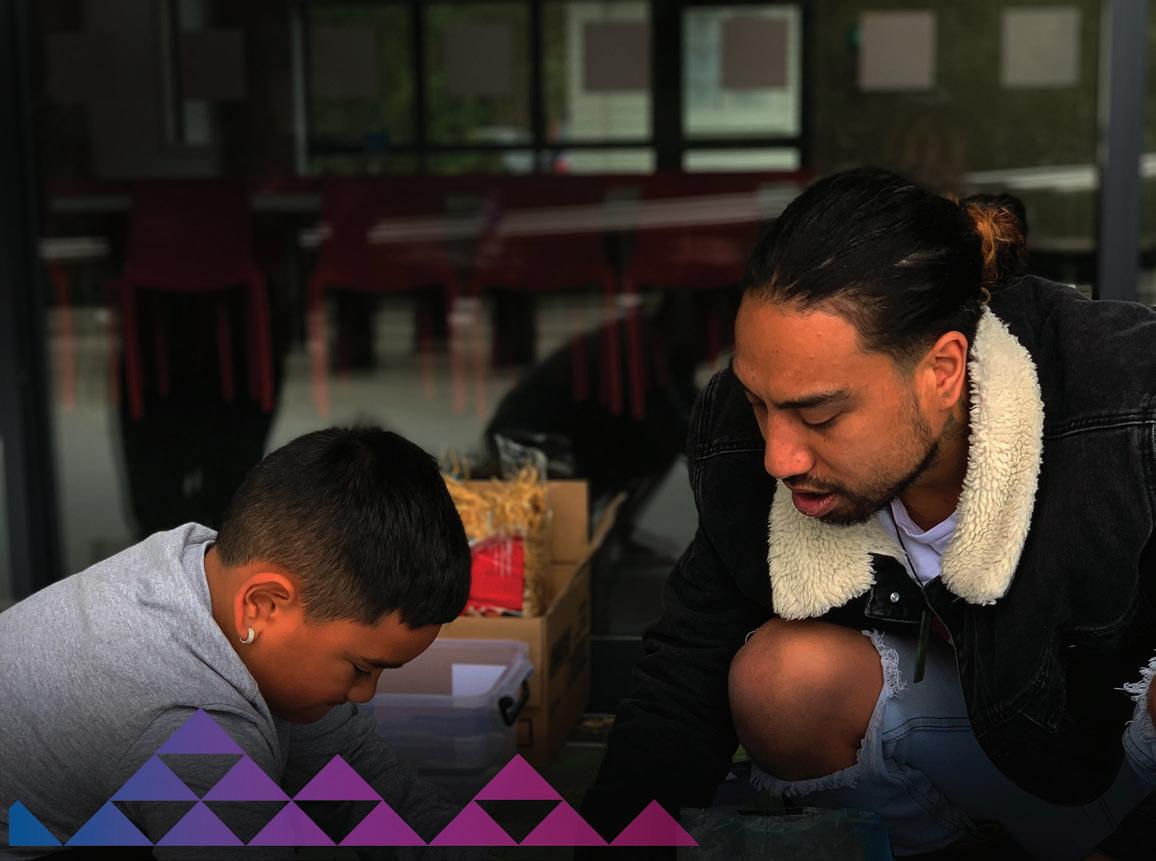

» The ‘school visits’ section on each place-specific webpage provides links to local educators or guides who can facilitate class visits.
» Tohu Whenua is a partnership between Manatū Taonga Ministry for Culture and Heritage, Heritage New Zealand Pouhere Taonga and Department of Conservation Te Papa Atawhai. Visit
9 Tukutuku Kōrero 28 August 2023
tohuwhenua.nz to start making history come alive for ākonga.
Pompallier Mission and Printery in the Bay of Islands. Photo: Mark Russell.
WORKFORCE
Early learning thrives with international teachers
We explore the value that overseas teachers bring to the early learning sector in Aotearoa – including fresh perspectives, global connections, reciprocal learning, and meeting the needs of diverse ākonga identities.
Su Costa says international teachers bring a really positive contribution to the early learning sector.
“Our overseas teachers are excited to be here and learn, and that makes the team excited too. It’s brought the spark back.”
The operations manager at Childcare & Learning Group (NZ), Su and her colleagues were concerned about the low numbers taking up early learning teacher training in Aotearoa before Covid hit, a situation which saw their ability to recruit quality teachers start to become challenging.
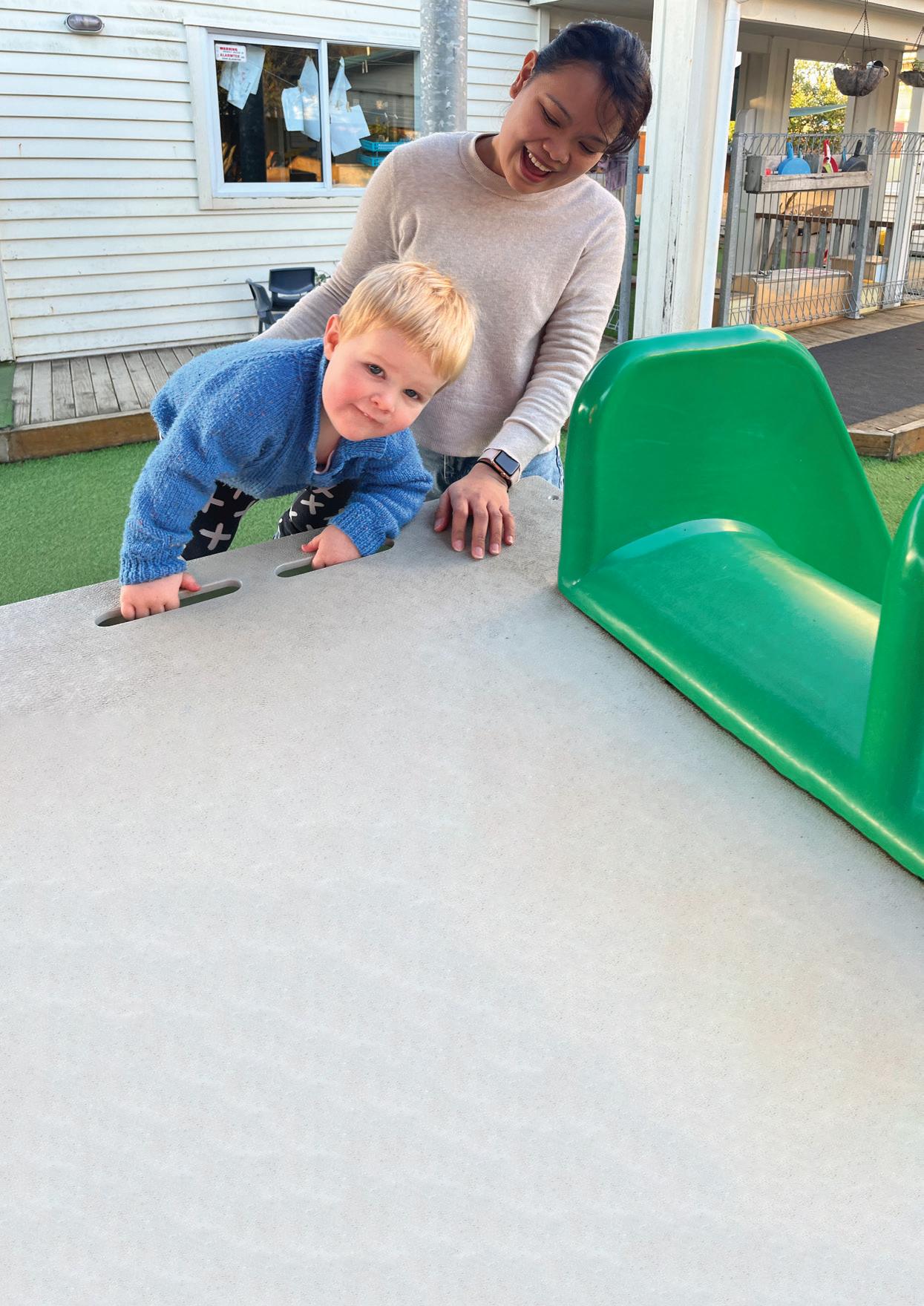
“From 2021, it became increasingly challenging. By
2022, particularly in Wellington, it became practically impossible.”
Su noticed that quality New Zealand-trained teachers looking for employment were “drops in an ocean of jobs being advertised”.
“For the survival of our centres, the support and wellbeing of our teachers and managers, and to support consistency for our tamariki, we had to take action and look overseas for teachers.”
Childcare & Learning Group now employs 16 internationally recruited teachers within their nine centres across Wellington, Auckland and Christchurch.
10
Education Gazette gazette.education.govt.nz
Lorenz Miralles is from the Phillipines and now teaches at Millie’s House Waiwhetu.
Su says these teachers are on Accredited Employer Workplace Visas – and some have now moved on to residence visas.
Value felt nationwide
They took the view that they weren’t just doing this for their centres, but also for the benefit of early learning in Aotearoa.
“New Zealand early learning was in a recruitment crisis, we wanted that to change, so we had to be a part of that change.”
Su says her centres are incredibly grateful to the Ministry of Education for providing resources and support to recruit internationally.
“Both the financial support to us as employers, and the financial support to make Aotearoa a possible destination for overseas teachers.”
There are two grants to support overseas teacher recruitment. Eligible schools, kura and early learning services can apply for the Overseas Finders Fee of up to $3,450 to help meet their recruitment costs.
Additionally, eligible overseas and returning New Zealand school, kura and early learning teachers have access to the overseas relocation grant of up to $10,000 towards the cost of relocating to Aoteraoa.
Growth in diversity
Recruiting internationally also brings benefits to the day-to-day culture and functioning of centres, Su says.
“For a teacher to go through this process – being interviewed, selected, and then take a huge leap of faith to move across the globe – they have grit, and an aspiration for a bright future. That grit and aspiration is so valuable in our centres.”
Su says the different perspective that overseas teachers bring is also invaluable.
“Whilst at the start that’s not always evident, when they begin to gain a sense of belonging in our centres, and are comfortable to share their perspective, it frees us as kaiako to look at things with a new lens and gain new learning too.”
International recruitment can also offer the opportunity to employ a diversity of teachers who reflect the diversity of the children and whānau engaging in early learning.
“This is local curriculum at its best; connecting people, culture and what matters here in our place. Our New Zealand kaiako learn from our overseas teachers as much as they learn from us,” says Su.
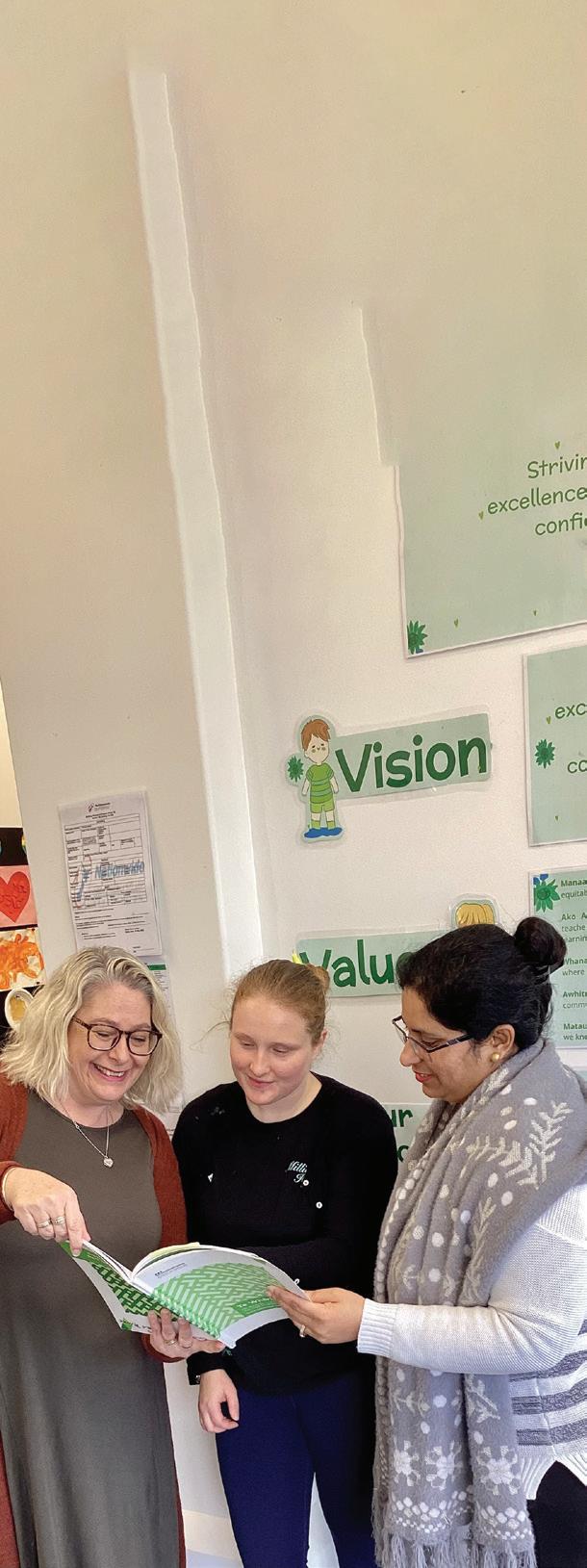
Reciprocal learning
Those benefits of reciprocal learning, between New Zealand and international teachers, are echoed by Childspace Early Learning Centres tumuaki Lauren Ryan, who also employs several overseas teachers.
“Our international kaiako bring a different perspective. I think we’re lucky in that a lot of our overseas teachers love our philosophy and want to learn more from us. But they also bring fresh ideas and fresh perspectives of different values for children’s learning.
11 Tukutuku Kōrero 28 August 2023
“This is local curriculum at its best; connecting people, culture and what matters here in our place. Our New Zealand kaiako learn from our overseas teachers as much as they learn from us.”
Su Costa
Alicja Lis is originally from Poland and studied early childhood education in Ireland.
“I love that our international teachers are all from different places. We’ve got a Chinese teacher, a South African teacher, an American teacher, an Sri Lankan teacher. It’s pretty special. They all have very different, but then also very similar, understandings of children and childhood and what we believe in.”
The diversity of experience is another positive for Lauren.
“International teachers are really keen to share their cultural backgrounds and celebrate their cultural events. And if you’ve got learners who share that culture, it’s so important for those children’s learning that their culture is celebrated and uplifted in such an authentic and meaningful way.”
Local context
Su Costa says upskilling international teachers to understand Te Whāriki and the local learning context is hugely important.
“Ahead of them coming to Aotearoa, we ask them to explore Te Whāriki online, we send webinars, a variety of links, and encourage them to fully explore the Teaching Council website for webinars and podcasts.
“During our interview process, we draw comparisons to the type of teaching they’ve been involved with and draw comparisons with our play-based philosophy and working culture.”
Once in Aotearoa, they take part in onboarding and induction for three months, then move into the professional growth cycle.
The importance of meaningful induction into the New Zealand teaching space is also a focus for Childspace, with Lauren describing some of the support provided to their overseas teachers.
“International teachers get a lot of on-the-job training, and because we have our Childspace Institute, we run specific induction programmes. We would also look to get them on a lot of relevant professional development.”
Find out more about international recruitment at education. govt.nz/news/overseas-teacherrecruitment.
For more information about navigators who support schools and early learning services recruiting overseas teachers, as well as overseas teachers themselves, email teacher. supply@education.govt.nz or call 0800 165 225 | +64 4 463-8602.
Lauren says the natural environment in Aotearoa is a big drawcard for teachers coming from overseas.
“Many overseas teachers who come here are really interested in our nature programmes. The strong links to te ao Māori in our nature programmes are very unique and can provide international teachers with entirely new ways of thinking.”
Intrigued by Aotearoa
Te Whāriki was a major drawcard for Alicja Lis, who is originally from Poland, and studied early childhood education in Ireland.
“When I was in college, EP Education from New Zealand came for a visit to talk to students about living and working here.
“It further sparked my curiosity about the early learning sector in New Zealand, as I was already intrigued by Te Whāriki and how it places children at the centre and encourages following their lead, development and interests.
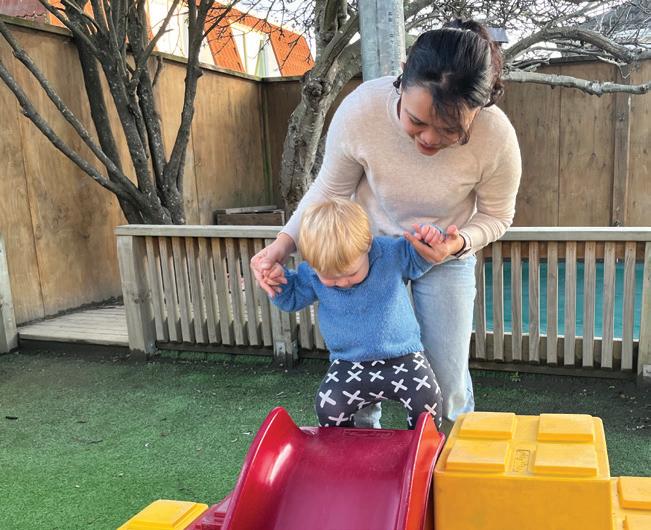
“Ireland has based a big part of their Early Childhood Curriculum, Aistear, on Te Whāriki so I had already applied some parts of it in practice, but I really wanted to experience what it is supposed to be like, and what could be a better place than in New Zealand itself?”
And for Lorenz Miralles, who comes from the Phillipines and now teaches at Millie’s House Waiwhetu, the hurdles to get work in Aotearoa were worth it.
“Working in a foreign country may seem intimidating to most people, but you will never know unless you take your chances. Myself, I wasn’t sure my New Zealand plans would fall into place. I just made baby steps each day – and now here I am.
“Learning the curriculum can be overwhelming, but never hesitate to seek help. People here are so helpful, and they don’t judge your perceived weakness or shortcomings as an overseas teacher. They see us eye to eye, as long as you show them your passion to succeed.”
12 Education Gazette gazette.education.govt.nz
Lorenz is enjoying living and working in Aotearoa as an early learning teacher.
Scholarships for Teaching English in Schools to Speakers of Other Languages (TESSOL)
TESSOL Scholarship applications are now open
You’re eligible to apply if you:
» are a New Zealand citizen or New Zealand resident
» work full-time or part-time in a state-funded school, or early childhood education service
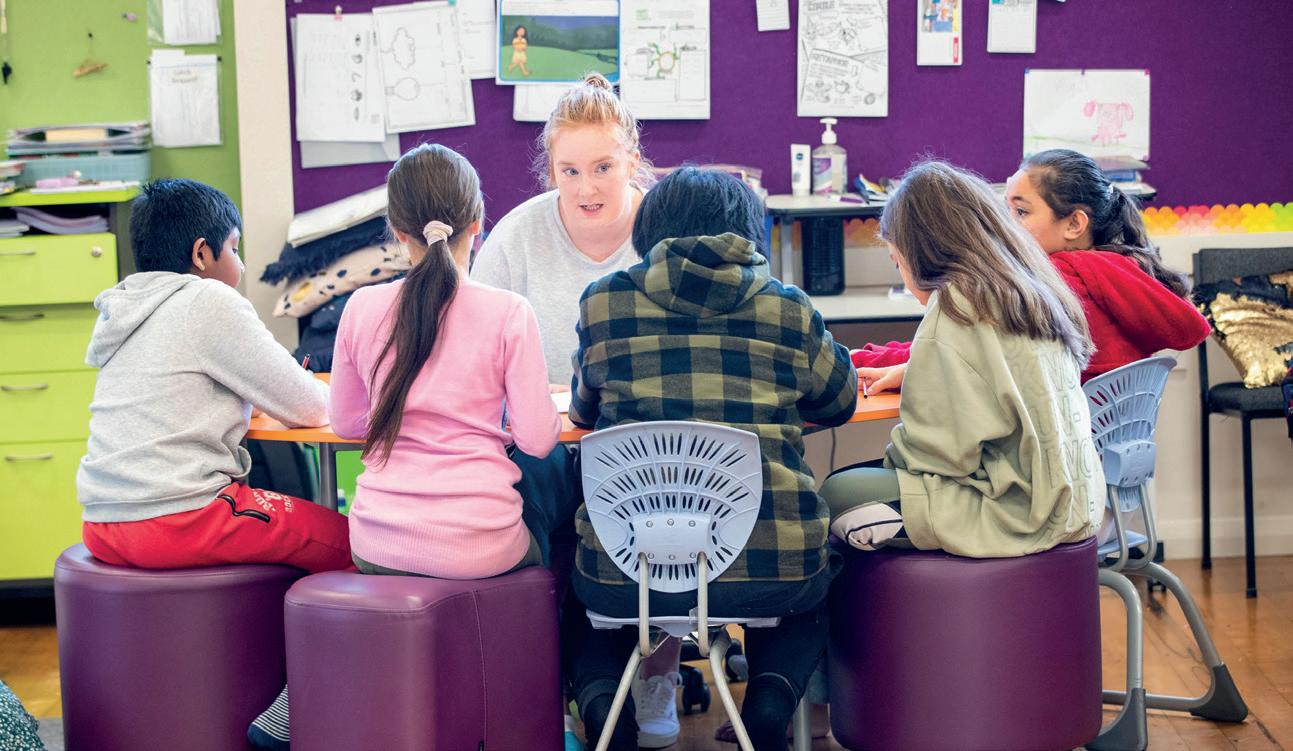
» are a New Zealand registered teacher in roles including:
› Subject and class teachers
› Teachers in bilingual settings
› Specialist ESOL teachers
› Members of the senior leadership team
› SENCO
› Learning support coordinators
› RTLB
› Early childhood educators
» have at least 2 years’ teaching experience
» have not received a TESSOL Scholarship before.
What the scholarship covers
The TESSOL Scholarship funds core papers of the qualification. This includes course fees for each paper and up to $200 towards course-related costs per annum (for 2 years).
TESSOL Providers
The University of Auckland, Faculty of Education and Social Work
Postgraduate Certificate/Diploma in Teaching Linguistically Diverse Learners (PGCert/Dip TLDL)
Waikato Institute of Technology
Graduate Diploma in Teaching English to Speakers of Other Languages (Grad Dip TESOL)
Massey University*
Graduate Certificate in Teaching English as an Additional Language (GradCert TEAL)
Victoria University of Wellington*
Post Graduate Certificate in Education (PGCertED), or the Post Graduate Diploma in Education (PGDipED)
University of Canterbury, College of Education*
The Postgraduate Certificate in Teaching English to Speakers of Other Languages (PGCertTESOL)/ Postgraduate Diploma in Education (Teaching and Learning Languages)
* distance learning available
Applications are due by 6 November 2023
Applications can be made via the Ministry of Education website: www.education.govt.nz/tessol/
“It was an extraordinary learning journey and the most useful professional development I have done.”
- 2020 TESSOL SCHOLARSHIP RECIPIENT
Growing great specialists in gifted education
Two recipients of Awards for Teachers of Gifted Learners and Gifted Study Awards kōrero about their specialist study, the ripple effect of knowledge and skills for other staff, and how together, they are better supporting the needs of their ākonga.
Gifted learners have specific needs when it comes to their learning and wellbeing and kaiako could benefit from professional learning and development to better understand and work with these ākonga.
The Ministry of Education offers two types of direct support to educators in this area. Firstly, they provide access to Learning Support Study Awards for the Postgraduate Diploma in Specialist Teaching offered by Massey University.
Secondly, there are Awards for Teachers of Gifted Learners, which can support kaiako and teachers in enhancing their skills so they can better support gifted learners.
Tania Plaisier and Melissa Powell have been fortunate to receive both a personal Learning Support Study Award in 2021, graduating this year, and an Award for Teachers of Gifted Learners at the start of 2023, with a focus on school development.
TANIA PLAISIER
Tania is the associate principal and special education needs coordinator (SENCo) at Maungawhau Primary School in Auckland.
Tania’s interest in gifted education originated from two main experiences: firstly, when she got the opportunity to work in a Year 7–8 extension class, and secondly, as she supported her twins’ educational journeys – one gifted and the other twice exceptional.

“I found out really quickly that the students in the class had very specific needs that I felt I needed to upskill on in order to meet their needs.”
In her current roles, Tania noticed that teachers in her school were unsure about how to identify and cater to the needs of gifted learners and that they needed support and guidance in this area.
Although she was confident in her educational practice in this field, she felt the best way to lead her staff was to
14 Education Gazette gazette.education.govt.nz
GIFTED EDUCATION
Giftedness could be across a range of areas, including the arts.
ensure she had a sound grasp of the theory and was current in her thinking.
Study as a pivot
Tania began her Postgraduate Diploma in Specialist Teaching in 2021 and felt she was immersed in new ways of thinking and learning and was immediately able to put these to use.

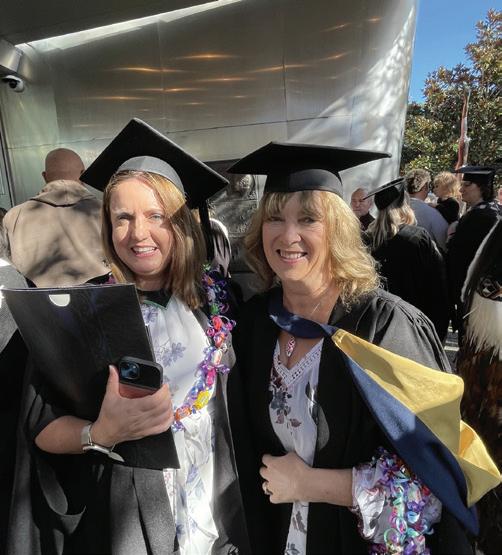
Over the past two years, she has successfully applied much of her learning by mentoring staff on the subject of giftedness, creating Individual Education Plans (IEPs) including strength or talent-based goals, and integrating her knowledge into the school’s foci on promoting depth and complexity in learning and supporting the social and emotional needs of all learners.
To elevate the recognition of and support for gifted learners, Maungawhau School has actively involved the community in discussions about the significance of giftedness, especially from a cultural perspective.
This approach has resulted in greater awareness and identification of gifted students within the school plus new opportunities that are being shared widely across her kāhui ako.
“It is important to have specialists in this field to upskill other teachers and to support those learners. I’ve really noticed an ongoing impact on our staff as a direct result of the study awards I have received.”
Impact as an incentive
Tania strongly believes that her specialist teaching study not only boosted her confidence in supporting both kaiako and gifted learners but also played a crucial role in shaping her career pathway. It has opened doors to opportunities she had never imagined or considered before.
“There’s been a lot of amazing opportunities that I’ve been able to be a part of. I can see it’s made a huge difference in my school. But I’ve also been able to use my expertise to support gifted learners in other schools, which is really exciting.”
It ultimately led to the school applying this year for an Award for Teachers of Gifted Learners which was used to work with their junior school around identification, supporting talent development and increasing depth and complexity in learning.
They are using the award to contract specialist mentors from GEMS Aotearoa who deliver workshops and 1:1 mentoring to kaiako to target specific areas the school wishes to develop.
“Feedback has been really positive around the new initiative, so much so the remainder of the school now wishes to get on board.”
MELISSA POWELL
Melissa is the kaihautū toi/head of the faculty of arts and kaiarahi ākonga/teacher in charge of student leaders at Rosehill College in Auckland.
Melissa’s interest in this field began from her personal experiences as a mother. One of her children achieved learning milestones at a very early age. This resulted in an unintentional lack of intellectual stimulation in class and led to her child feeling resentful towards school and teachers.
“I became more and more aware of the lack of learning opportunities she was experiencing, and this increased my awareness of what I was doing in my own classrooms.”
15 Tukutuku Kōrero 28 August 2023
“It is important to have specialists in this field to upskill other teachers and to support those learners.”
Tania Plaisier
Tania Plaisier (above) and Melissa Powell (below) with Deb Walker at their graduation in 2023.
This growth in awareness became the driving force behind Melissa applying for a Learning Support Study Award and entering the postgraduate programme in 2021.
Involvement in study
“Massey University gave me an opportunity to do a deep-dive into my own practice and equip myself with the knowledge and experiences that would allow me to support others. One aspect I really enjoyed was the encouragement to learn with, from, and about others right across the education sector, as this made me think far broader about support and impacts.”
Melissa acknowledges the decision to undertake postgraduate study has greatly extended her ability to support gifted learners within her school setting.
She has personally trialled several different approaches with learners and has been able to apply her new skills and ideas directly into her teaching practice.
“Engaging with the Specialist Teaching Programme enabled me to make a huge variety of connections. It both forced and enabled me to grow in my own practice, boosted my confidence, and ultimately opened up further leadership pathways for me within my school.”
Ripples
With her newly acquired expertise, Melissa has been able to deliver professional learning within her school and her kāhui ako.
She also has had the opportunity to present a webinar for Gifted NEX and became a mentor for GEMS Aotearoa. In addition, she has kept her link with Massey University by becoming an Ākongi Hoki, a programme graduate mentor for current students.
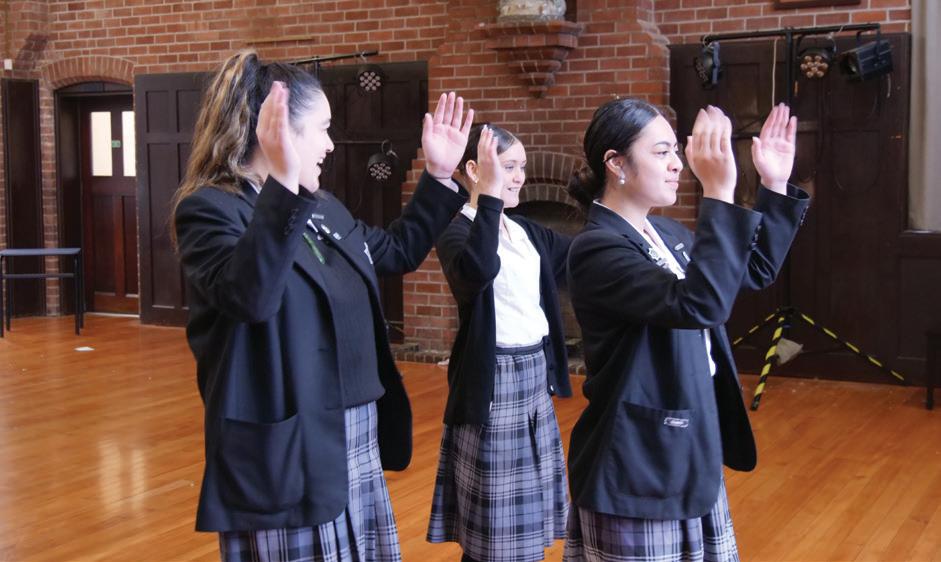
“This journey has opened opportunities I had never thought of. It has stretched me as a practitioner and as a leader, and I am incredibly grateful.”
This year, Rosehill College received additional support in the way of the Awards for Teachers of Gifted Learners.
Melissa and her colleague, Anita Minton, who is currently undertaking the postgraduate diploma endorsed in gifted education, have used their study and the award to undertake additional professional learning and development, visit schools and interact with their community to develop a new programme of learning, enrichment and extension (LEAP) that will be implemented in their junior school in 2024.
16 Education Gazette gazette.education.govt.nz
“What began as a quest for knowledge and for tools to add to my kete, has turned into an adventure for our kura. I can already see the difference … making a positive impact for the gifted learners across our country.”
Melissa Powell
St Mary’s College students in Wellington are previous recipients of the Ministry of Education’s Awards for Gifted Learners which is separate from Awards for Teachers of Gifted Learners and Gifted Study Awards. For more info, visit gifted.tki.org.nz/further-support/awards.
“What began as a quest for knowledge and for tools to add to my kete, has turned into an adventure for our kura. I can already see the difference in myself and look forward to being part of the Specialist Teachers of Gifted network, making a positive impact for the gifted learners across our country.”
A worthwhile investment
The Learning Support Study Awards are designed to invest in teachers by providing them with specialised knowledge.
Currently, the programme offers eight endorsements: advisor on deaf children; blind and low vision; complex educational needs; deaf and hard of hearing; early intervention; gifted; Te Kaupapa o Te Kōhanga Reo plus learning and behaviour.
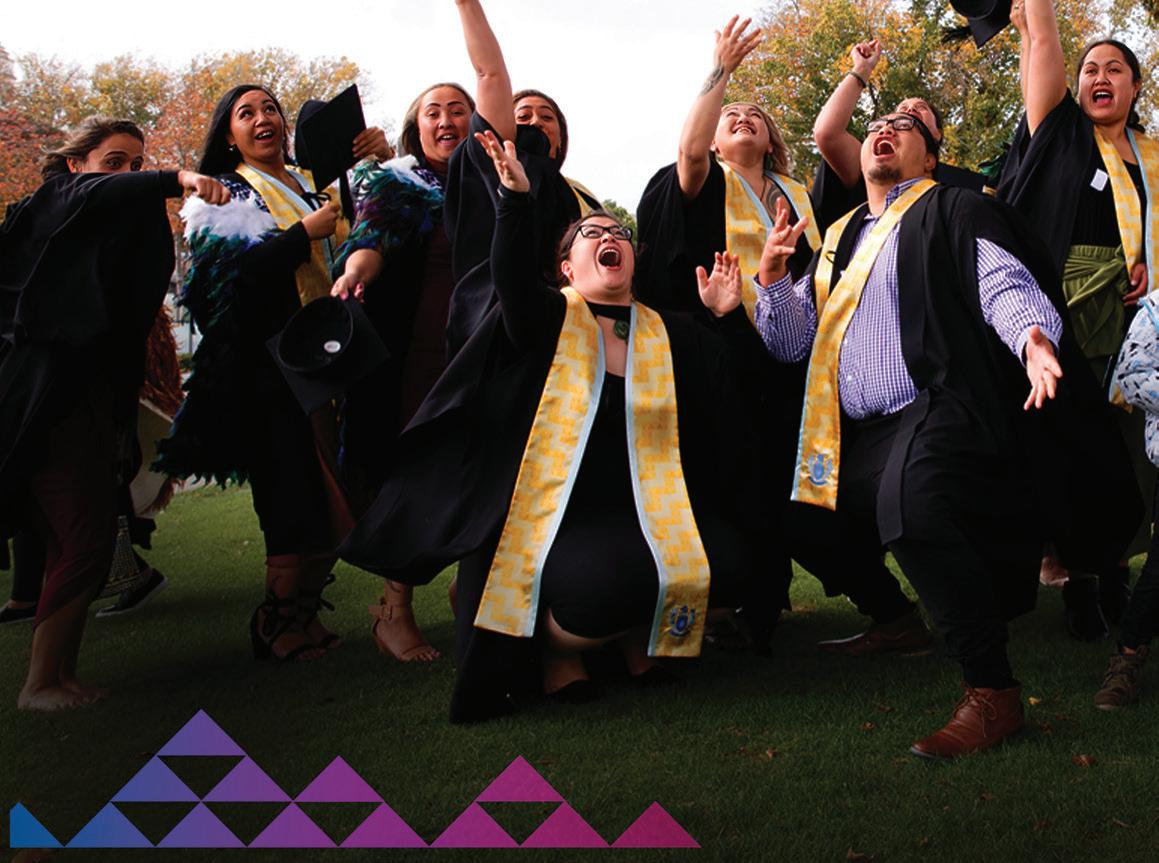
“Becoming a specialist educator in any field provides depth to your skill set and can potentially challenge and grow your career path. However, the ultimate benefit is to any set of learners who need to know they are supported by not only educators who care, but educators who know how to care,” says Deb Walker, specialist teaching programme coordinator (gifted) at Massey University.
“Participating in opportunities where you interact with others who have expertise and experience to support your journey can only be a win-win situation.”
The 2024 round of applications for the Learning Support Study Awards opened on 1 August and closes on 30 September.
Awards for Teachers of Gifted Learners are for teachers currently working in early learning, primary or secondary schools in Aotearoa New Zealand, to support them in enhancing their skills so they can better support gifted learners. Applications for 2023 open on 2 October and close on 5 November.
Awards for Teachers of Gifted Learners (gifted.tki.org.nz)
Gifted Study Awards (education.govt.nz)
For queries, email gifted.enquiries@education.govt.nz.
HEI RAUKURA MŌ TŌNA IWI
17 Tukutuku Kōrero 28 August 2023
TE AHO PAEREWA Kei tō taiao ako ngā rangatira mō āpōpō. Tū mai hei pouako reo Māori me te whai i Te Aho Paerewa i te tau Kotahi. RAPUA HE KŌRERO MASSEY.AC.NZ
Connected Ako: Digital and Data for Learning
Digital changemakers in action! The goal is for students to leave Te Ara Poutama knowing they have the skills and knowledge to go out and do anything.
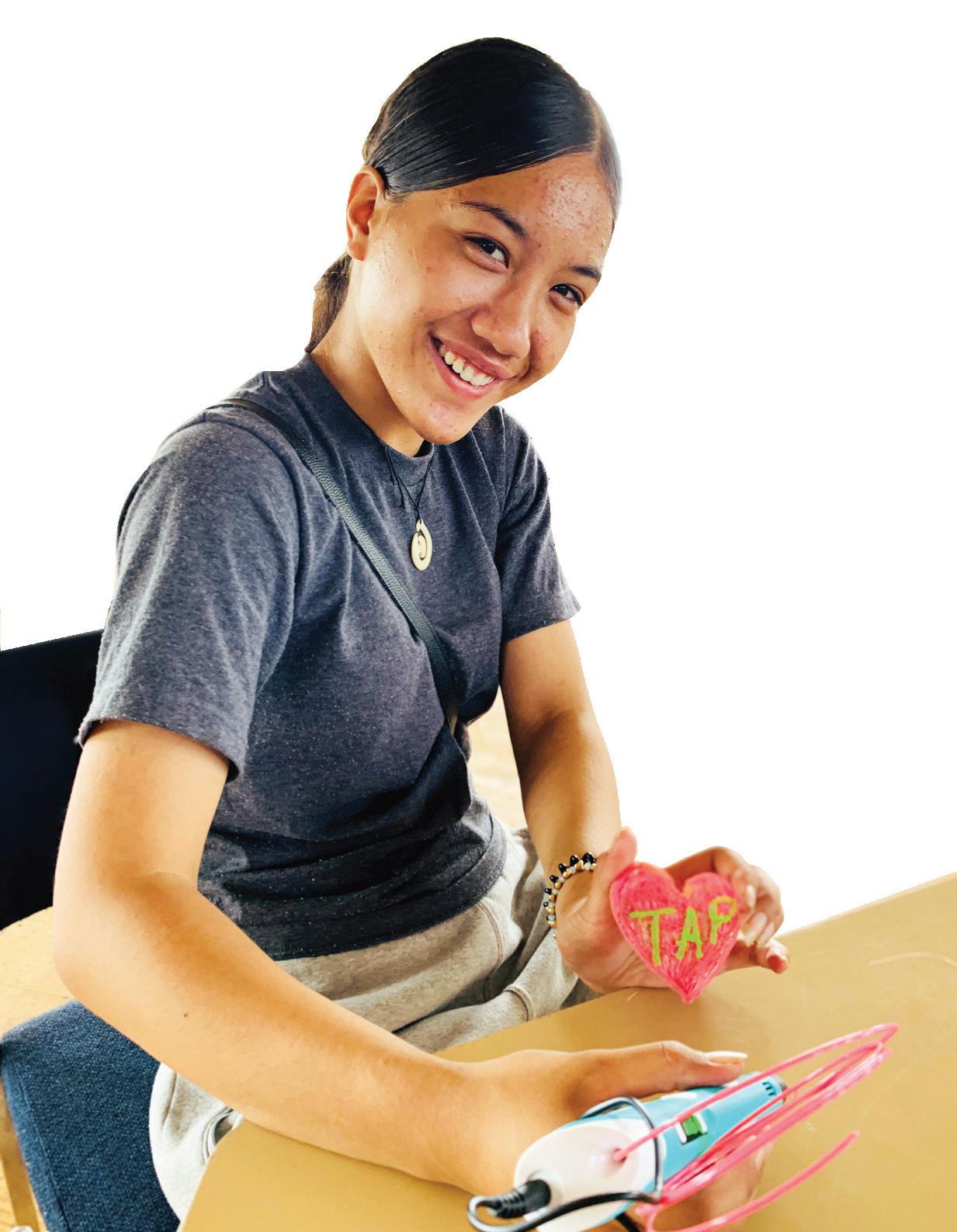
18
Focus:
Collaboration key to transforming lives of rangatahi through EdTech
Focus:
Education Technology (EdTech) is inspiring and empowering rangatahi who attend Te Ara Poutama Alternative Education Centre in Manurewa.
“Before, ākonga were aiming for factory jobs, warehousing, roading, that kind of thing, whereas now, their goals and dreams have changed so that they’re actually talking about tech-based jobs,” says Chantelle Foketi, general manager of Te Ara Poutama Alternative Education Centre.
The power of EdTech is evident as soon as you walk through the doors of the Makerspace at the centre.
The centre’s Makerspace gives young people access to industry technology, opening their eyes to the digital world and creating opportunities for the betterment of their future.
Fondly known as the Innovation Station, the Makerspace has been brought to life through powerful partnerships and engagement with many stakeholders.
There are CNC machines (motorised manoeuvrable tools involved in manufacturing), 3D printers and a range of other industry technology. Rangatahi there are not only engrossed in what they are doing, but they are taking the lead and teaching others the skills they’ve learned.
The centre, based in Manurewa, has long provided a safe learning space for young people who have left school.
“A lot of the students when they first come here, they have come from the schooling system that has let them down, mostly because it doesn’t fit the way they learn, or how they learn,” says tutor Dornae Rae.
But the Makerspace is a new initiative transforming learning, equipping young people with skills for the future, and changing lives.
Addressing the digital divide
The idea of Makerspace was born during the first Covid lockdown in March 2020, says Chantelle.
“Suddenly we all had to work from home, and our students weren’t able to, most of them had no internet. There were definitely no devices in the home.”
Chantelle says once lockdown ended, it was clear what they needed to do.
“Once we came back to class, we kind of got into the mindset that we had to get the kids ready, digitally ready, to work.”
And so, the Makerspace was born.
“We call it the Innovation Station because we want it to be a place where innovation happens,” says Dornae.
“It’s a space where you can come and have a go. You know, you don’t have to own any of this stuff. We’ve got it for you.”
Collaboration is key
There are a diverse range of stakeholders involved in the creation of Makerspace including the Ministry of Education, OMGTech!, Google, Microsoft, and other organisations. The Ministry’s Te Mahau regional team have been key enablers in this mahi as part of their championing of digital equity initiatives through partnership with tech organisations and industry.
Zoe Timbrell is co-founder of OMGTech!, an initiative run by the Pam Fergusson Charitable Trust. The charity supports the education sector, communities, and the public in exploring how the future of technology can change lives.
“Students face a lot of challenges with digital technology, like access and interest. Te Ara Poutama students face even more challenges as an alternative education provider,” says Zoe.
Te Ara Poutama have “a really clear vision for the future of their students” and know collaboration is a “critical” part of their success,” she says.
“They work really hard to find the right partners that are going to work with their students in the best way, and we are really fortunate to get to be one of those partners, and to work alongside them and others to achieve their vision with their students.”
Dornae says partnerships are “vital”.
“Partnering with OMGTech!, partnering with Microsoft, partnering with Google – any of the tech sector partnerships – to help build the students, help to build the community,
19 Tukutuku Kōrero 28 August 2023
Engaging widely and effectively
because it’s not something that can be done alone.”
The importance of partnerships is highlighted in Connected Ako: Digital and Data for Learning which acknowledges the best digital approaches for education require contributions from diverse participants, enabling and encouraging innovation.
And innovation is exactly what is happening at Te Ara Poutama.
“We know that this isn’t just digital fluency, it’s not using social media,” says Zoe.
“The students here are being taught skills for the future, for jobs. They’ve got CNC machines, they’re going to be our digital manufacturers of the future, and it’s critical to have the right tools to do that.”
EdTech is a growing global industry – impacting the experience and opportunities for youth.
The Aotearoa EdTech Excellence Report shows US$404 billion was spent on EdTech globally in 2020. New Zealand’s spend on education software alone was $173.6m in 2020 and that figure is expected to almost double to $319.6m by 2025.
The report also noted EdTech provides many benefits for New Zealand including increased access to education, the ability to cater to students for whom traditional education models don’t work, magnified economic benefits for the EdTech sector and all of Aotearoa, and increased equity in education.
Transforming the lives of young people
It’s clear the rangatahi at Te Ara Poutama have had their lives transformed by EdTech.
Chantelle says it has opened the students’ eyes to the future of technology and the job prospects available.
Kaiha, a student at Te Ara Poutama, is an example of this.
“I’m doing a digital job right now. I’m a digital intern. It’s a place that’s helped me getting me a job, and helping me in my future plans,” he says.
“Before I came to Te Ara Poutama, I probably wanted to work with my dad. But after I came here, and started learning here and drawing more, I probably thought that animating and becoming an animator was my best option.”
Student Amethyst says many of the students who attend Te Ara Poutama either failed school or never started it.
She says alternative education gave them hope and a second chance, and through Makerspace they have learned skills for the future.
“We do a lot of 3D printing, a lot of coding. People should know computer literate skills. We’re getting into a generation where we’re going to be more hands on with devices.”
Student Shyrahn says Makerspace has enabled him to obtain skills he wouldn’t otherwise learn.
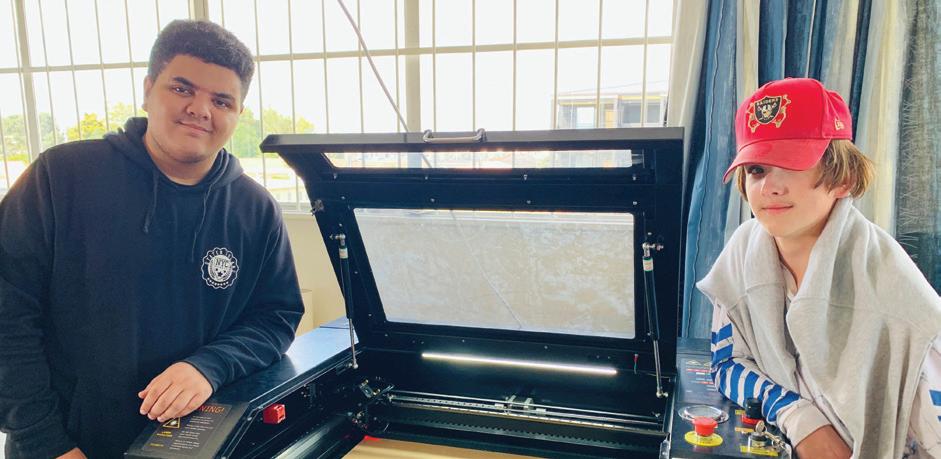
“I just love to learn, that’s the thing, and this course is better than high school,” he says.
“I can basically do a lot of things. I can base cut some board or do some T-shirt pressing, and back at high school I couldn’t do that stuff.”
Chantelle says it was important the Makerspace was student-run, so four students were chosen as potential leaders.
Now those students – like Amethyst – are taking what they’ve learned and passing on their knowledge.
“Our goal is to teach others what we’ve been taught in the past year,” says Amethyst.
“We’re wanting to open this up to the community, show them what we’ve made, teach them too. We just want to be more involved.”
Amethyst says she has changed “so much” since being at Te Ara Poutama.
“That’s all my parents ever wanted. To not see me at home, you know, with no books. They’d rather see me here, coming home happy. I can be me, without having to change something about myself,” she says.
Dornae says the ultimate goal is for students to leave Te Ara Poutama knowing they have the skills and knowledge to go out and do anything. Watching these rangatahi in action it is clear that they are the digital changemakers of the future.
Watch the video showing how Amethyst, Kaiha, Shyrahn and others are learning digital skills that are opening doors to exciting future possibilities.
20 Education Gazette gazette.education.govt.nz
Students are learning technical skills which are opening doors to jobs in the digital future.
Supporting digital equity and inclusion
Collaboration between the Ministry of Education, schools, and the technology sector is supporting digital equity and inclusion.
Te Ara Poutama Alternative Education Centre in Manurewa is part of the South Auckland STEAM equity community (SASTEAM) initiated by the Ministry’s Te Mahau regional team – a youth-centric collective focused on ngā rangatira mo āpōpō, the leaders of the future.
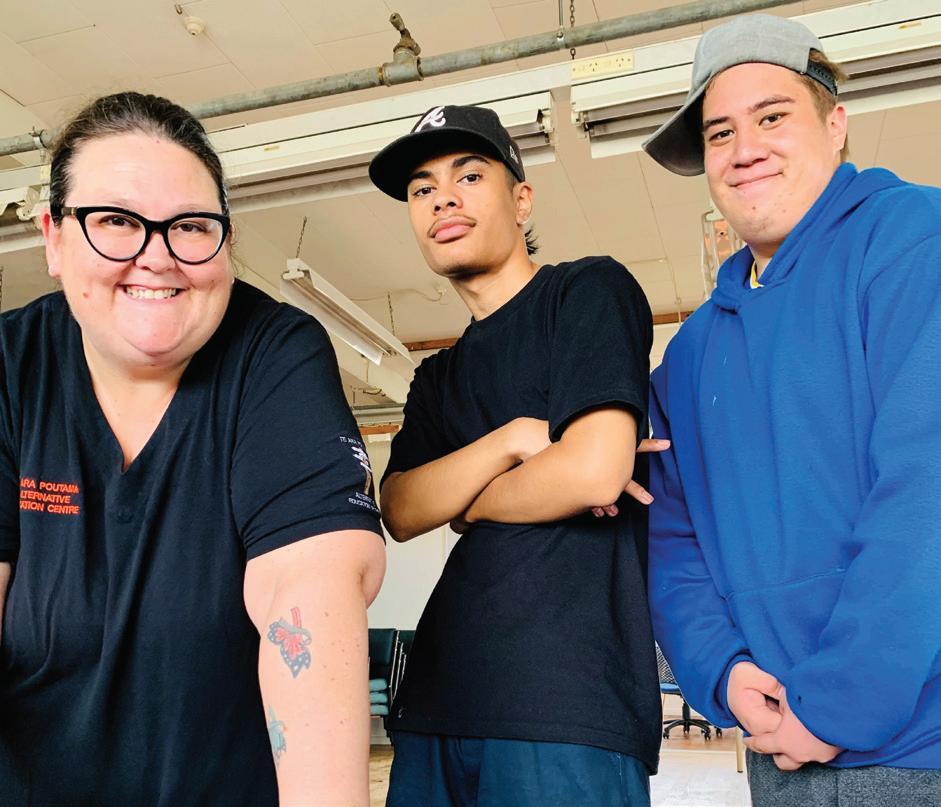
SASTEAM champions STEAM equity for Māori and Pacific rangatahi so they can become leaders and changemakers in the digital world.
Many local school leaders are engaged in this mahi and the focus is to work in partnership with the tech industry to design and provide rich learning opportunities to inspire students to consider STEAM pathways.
Built on a collective impact model, it includes youth and educators (technology leaders, principals, and career advisors) from South Auckland schools, technology companies, technology charities, NGOs, and government agencies.
Priorities outlined by youth, for youth, include digital accessibility, whānau partnership, local curriculum design (STEAM), transitions and pathways, and youth leadership and wellbeing.
Educators are continuing to collaborate across schools to share and create effective strategies to strengthen powerful partnerships with whānau, co-design rich opportunities for learning, improve transitions and pathways and wellbeing.
The SASTEAM community aspires to democratise access to opportunities for Māori and Pacific youth by closing the gap between youth and the tech industry. How? Collaboration is key!
Learn
21 Tukutuku Kōrero 28 August 2023
more at
pamfergusson.org.nz/sasteamm
sites.google.com/
Tutor Dornae explains how the Makerspace is enabling students to obtain skills for a digitally powered future
Collaboration success with right connections
Zoe Timbrell, kaiwhakahaere and co-founder of OMGTech! (Pam Fergusson Charitable Trust), says collaboration is critical to show ākonga the real world.

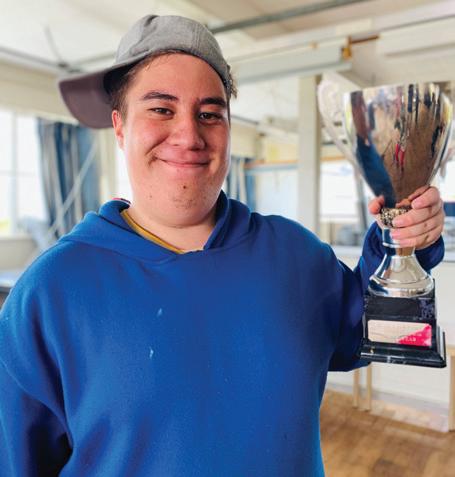
“We bring the right people to the table and specialise in making vital connections between whānau, communities and the awesome range of tech companies in Aotearoa (and beyond).
“The ākonga need to understand that the world they are living in, learning in, and eventually working in is digitally enabled, and it is unlike the world their parents know. For them to thrive in this new connected world, they have to be willing to learn and adapt faster than any other generation before them.
“Introducing a new concept requires both access and interest. The project at Te Ara Poutama shows how partnerships can lead to both and, more importantly, a change in mindset for the ākonga involved.
“From being resigned to a pre-determined fate and career pathway, ākonga can now see the vast prospects available to them, well within their skill sets and passions.”
Engaging widely and effectively
Education agencies will work with many across the sector and more broadly to bring coherence and leadership – including education providers, iwi, technology providers, business and communities.
The best digital approaches for education require contributions from diverse participants, enabling and encouraging innovation. There is a need to work together with communities, iwi, learners, teachers, EdTech, and with wider government agencies. Good ideas, new approaches and transformational shifts can come from anywhere. National planning is important.
So too are community solutions to local issues. Locally designed products and services can bring cultural responsiveness and awareness of te ao Māori and community aspirations in ways that are attuned to local needs.
Education agencies are prioritising working with diverse stakeholders on building inclusive digital approaches.
Learn more at education.govt.nz/digitalstrategy
Collaboration is key.
22 Education Gazette gazette.education.govt.nz
“Think today about how you can make these links for your school or kura. Reach out. Real-life magic happens when partnerships are created between your ākonga and their passions.”
Zoe Timbrell
Youth are becoming digital changemakers and taking on leadership roles.
Introducing Te Puna Kōrero: Celebrating
stories of digital success in education
Education Gazette is offering a series of articles highlighting digital success stories from across the education sector.
Stories like this one of new approaches to digital in education are being regularly showcased. This series will introduce you to students and educators from early childhood, compulsory schooling, alternative education, and tertiary.
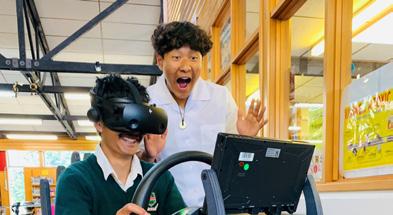
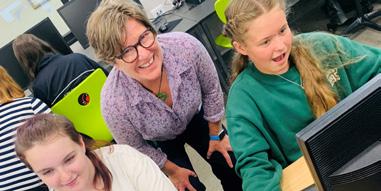
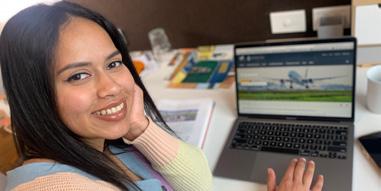
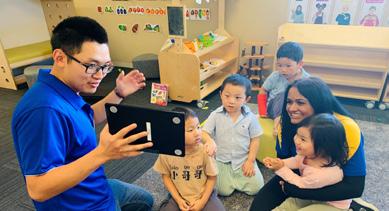
from Digimatua (who is building digital skills for Pacific families to be able to better support their children’s education), and many others.
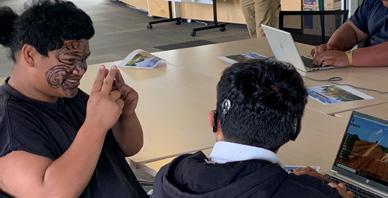
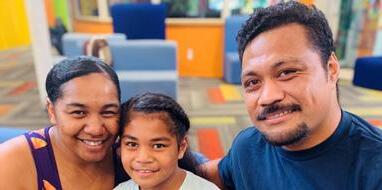
All videos are available online at education.govt.nz/ digitalstrategy. All articles will be available online at gazette.education.nz.
You will meet
(who is using digital to share butterfly stories in her early childhood centre), Romana
23 Tukutuku Kōrero 28 August 2023
kaiako Rakhee
How is learning with technology expanding young minds at JustKidz Early Childhood Education Centre, Henderson?
How is data better identifying learners in need of support at Massey University?
How are families with stronger digital skills better supporting children’s education with Digimatua’s Pacific community digital inclusion programme?
How can te ao Māori impact a digital world to create a special place for deaf learners at Rūaumoko Marae?
How is building teachers’ digital skills sparking imagination in learners at Avonside Girls’ High School?
How is learning in a virtual world making young Kiwis safer drivers at Waimate High School?
Future-focused ākonga STEAM ahead with national challenge
Solving tomorrow’s problems, today. Ākonga across the motu are leaning into cross-curriculum learning in new ways through a nationwide challenge.
Enthused and engaged learners from Howick College have excelled at problem solving, with a win in a nationwide competition last year – and they’re going all out to build on their success in this year’s Samsung Solve for Tomorrow challenge.
Aimed at providing richness of learning across subjects, sparking innovation and forward thinking, Samsung’s Solve for Tomorrow competition asks secondary school students to develop solutions to existing problems, ‘Empowering Kiwi kids to change the world for good using STEAM’.
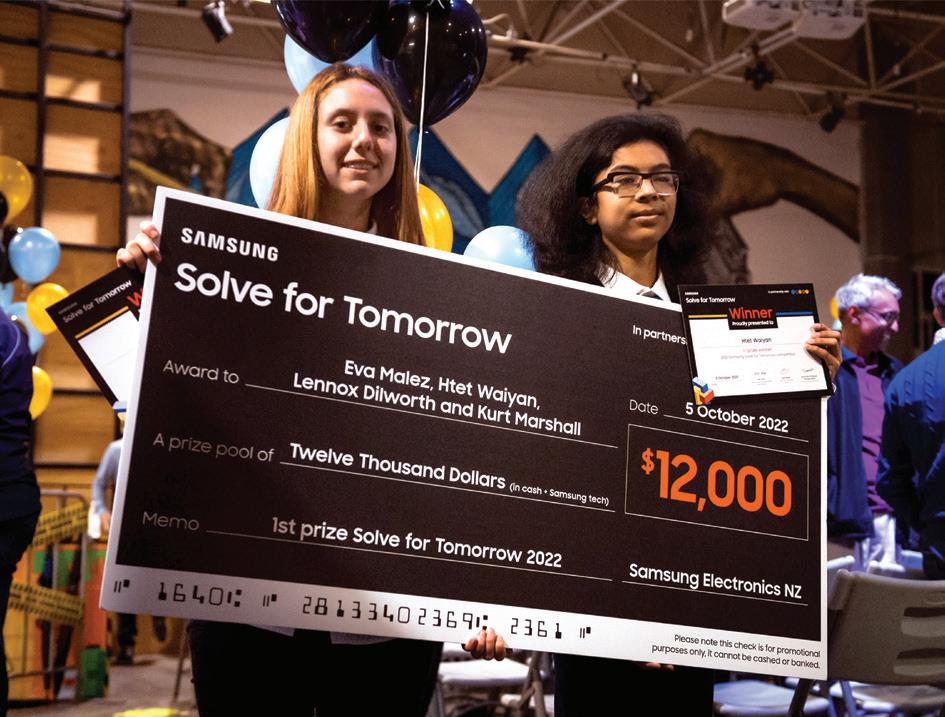
With a wide scope of potential issues to address, ākonga at Howick College have been guided by textiles teacher Nikki Metcalfe to turn their ingenuity-fuelled inventions into reality.
“The aim was to create a product that resolves a current issue in the community. Students looked at what areas they were interested in and were encouraged to take a human-centred approach to their research – putting the person at the centre of their problem-solving ideas.”
24 Education Gazette gazette.education.govt.nz
STEAM
Samsung Solve for Tomorrow 2022 winners, Eva Malez and Htet Waiyan, after receiving their prizes at last year’s awards ceremony.
Teaching collaboration
Project-based learning was integrated into the curriculum, with Year 9 students extending their knowledge and skills across Science, Technology, Engineering, the Arts, and Maths,, and collaboration proving one of the most vital skills, says Nikki.
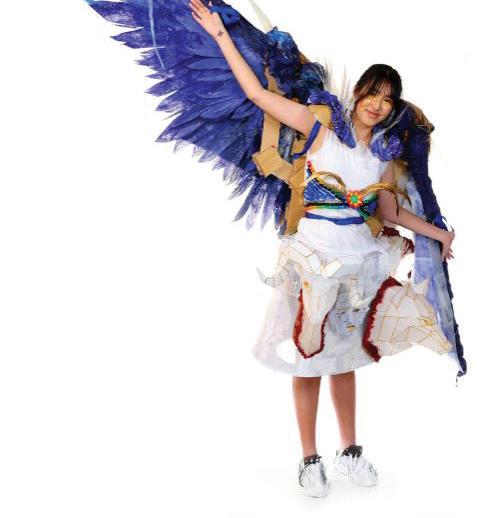
“The students had to work in groups and learn how to collaborate. It’s not always easy for young teenagers to work together effectively!
“They quickly learned how some people step up and lead in a group situation and they discovered the different ways people communicate their thoughts and feelings.”
Producing last year’s national winner in the competition, Howick has set a high bar as this year’s groups immerse themselves in the design stage. In 2022, one of Nikki’s student groups took out the win with a non-invasive device to check blood sugar levels for diabetics.
“A Year 9 student had this concept they brought to the competition, which solved a real, medical issue that impacts so many people living with diabetes. Realising that we are able to measure levels of ketones through a breathalyser, she and her group combined that technology to create a device that was able to test blood sugar levels without the need for invasive needles.
“We thought this was a phenomenal invention; an incredible solution to a very real problem affecting many people, not just here but around the world.”
Since winning last year’s challenge, the students are continuing to fine-tune their invention.
“It still has some honing to do. One of the students learned coding and electronics to make this idea she had for a device, a reality. I’m surprised a medical company hasn’t snapped it up – it really could be a massive game changer with some more refining and development.”
Cross-curricular
Nationwide, the competition attracted entries including kitchen utensils that are safer for people with disabilities to use, a school cycling programme encouraging young people to bike instead of drive to school, and a tool to help children not drop their teddies at night.
The competition is open to students in Years 5–10 to solve an issue in their community, using Science, Technology, Engineering, the Arts, and Maths.
One of the school’s innovation subject stream leads, Nikki outlined the areas of the curriculum covered by her students during the project.
“Science was involved in terms of the data gathered and used in the making of some of the products. Students had to integrate technology, deciding which components were needed to take their product from design to build. Engineering and electronics were considered in how different components related to each other to make their idea work.
“English was also a part of the process, as the students needed to carry out presentations and communicate their ideas.
“In terms of the arts, they had to consider how to make their product look good – they realised the role aesthetics can play in the success of a product. And maths was involved in coding, which then tied back to technology.”
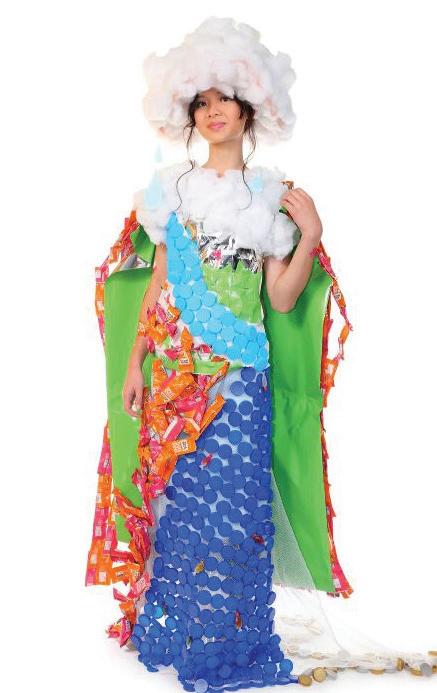
28 August 2023
“I love it when students enter competitions because it really motivates them to do well. Teenagers have come up with so many brilliant inventions and solutions to problems.”
Nikki Metcalfe
These images showcase a wearable arts project at Howick College.
Nikki says students also extended their learning in social studies, ethics, and consumerism.
The competition
Led by Samsung, and delivered in partnership with Museum of Transport and Technology Auckland (MOTAT) and Technology Education New Zealand (TENZ), the competition awards up to $20,000 in cash prizes and Samsung technology.
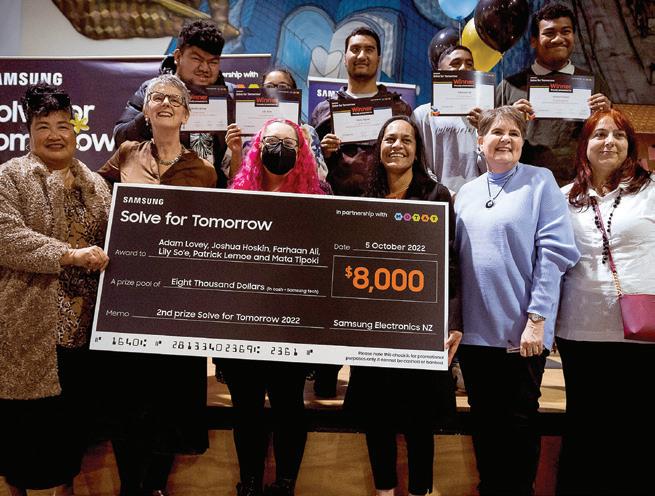
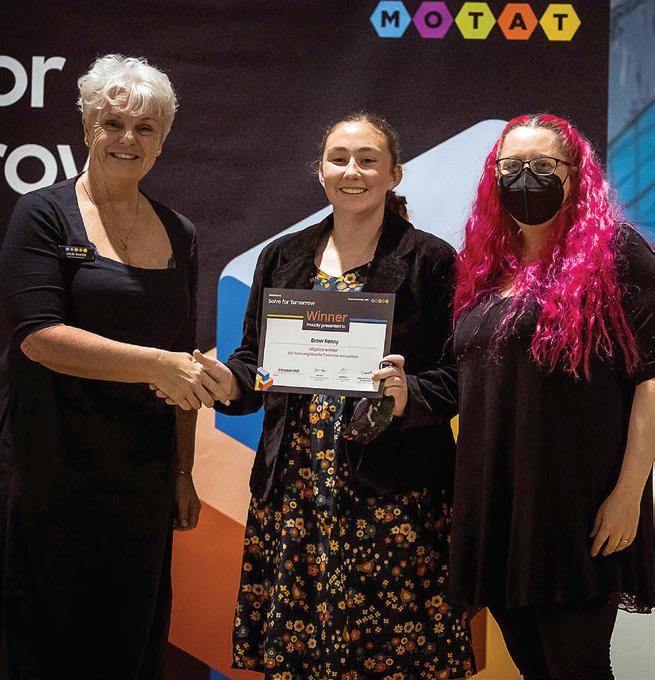
The programme has been designed to align with New Zealand’s National Education and Learning Priorities (NELP) and to be inclusive to all ākonga in Years 5–10.
Nikki has found her students respond well to competition entry.
“I love it when students enter competitions because it really motivates them to do well. When I heard about this Samsung Solve for Tomorrow, I thought why not use it as a goal and a way to encourage students to put all their effort in. Teenagers have come up with so many brilliant inventions and solutions to problems, because they don’t second guess themselves, and they’re full of ideas.
“The learning these students have experienced through engaging in this challenge has been so rich and varied – it really has been phenomenal.”
Associate Professor Dr Siouxsie Wiles and scientist/ researcher Dr Joel Rindelaub are among the competition’s judges for 2023, alongside MOTAT’s education lead Julie Baker, and deputy chair of TENZ, Sarah Washbrooke.
Julie says in three years, they’ve seen this competition really grow and mature.
“It was great to see students practising the design thinking process last year. There was a huge improvement in solutions from the first time we saw their plans to the final entries they submitted. By developing problemsolving skills now, students will be equipped with the tools they need for their upcoming careers.”
Information for kaiako
There are plenty of opportunities for teachers and students to receive additional support to strengthen entries to the competition this year, says Julie.
Advice for Year 5-10 teachers:
» Design thinking process: Teachers can also download a series of step-by-step worksheets developed by TENZ to help entrants work through the design thinking process and make their entries the best they can be.
» Science Fair: If students have already submitted a Science Fair project, its super easy and fast to adapt this into a Samsung Solve for Tomorrow submission. It’s important to check the project meets the judging criteria.
» Webinars: MOTAT and TENZ are hosting interactive webinars for each step of the Samsung Solve for Tomorrow entry process, designed for teachers and parents.
26 Education Gazette
“By developing problem-solving skills now, students will be equipped with the tools they need for their upcoming careers.”
Julie Baker
gazette.education.govt.nz
Samsung Solve for Tomorrow 2021 co-winner Drew Kenny receiving her award from judges Julie Baker and Dr Siouxsie Wiles.
Samsung Solve for Tomorrow 2022 runners-up from Mt Richmond Special school with Dr Siouxsie Wiles.
Teachers can find additional resources on the Samsung Solve for Tomorrow website, samsung.com/ nz/solvefortomorrow/resources
Final entries need to be submitted by 4 September.
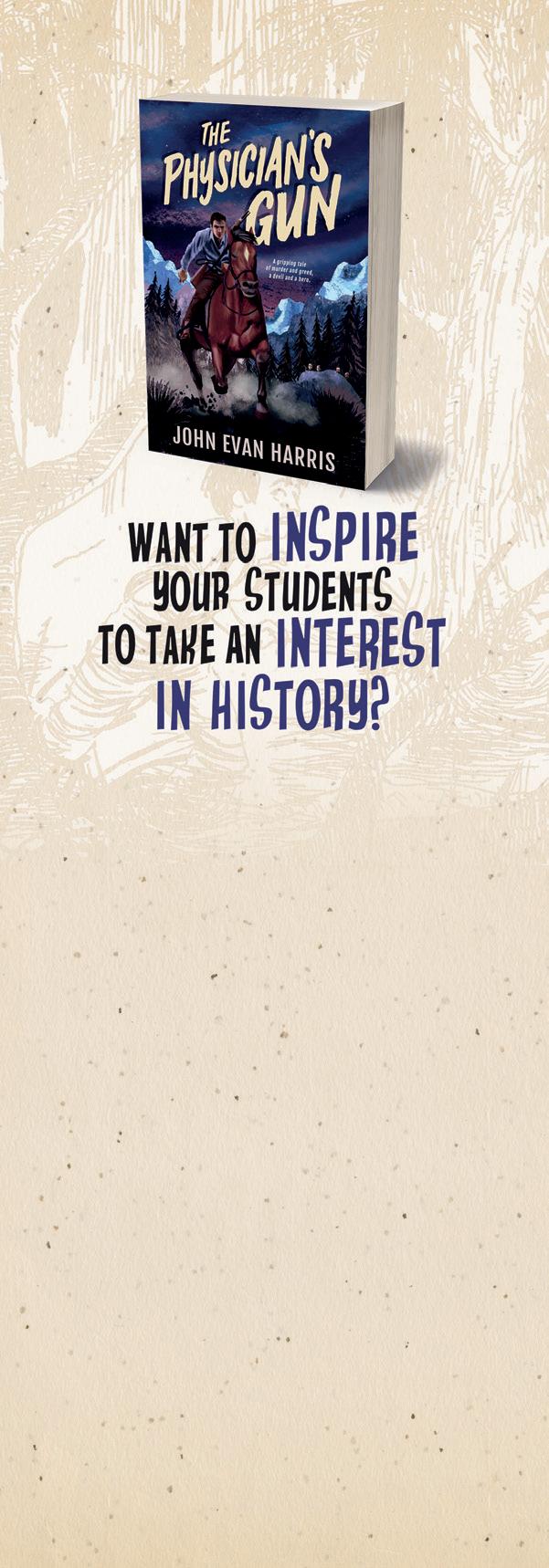
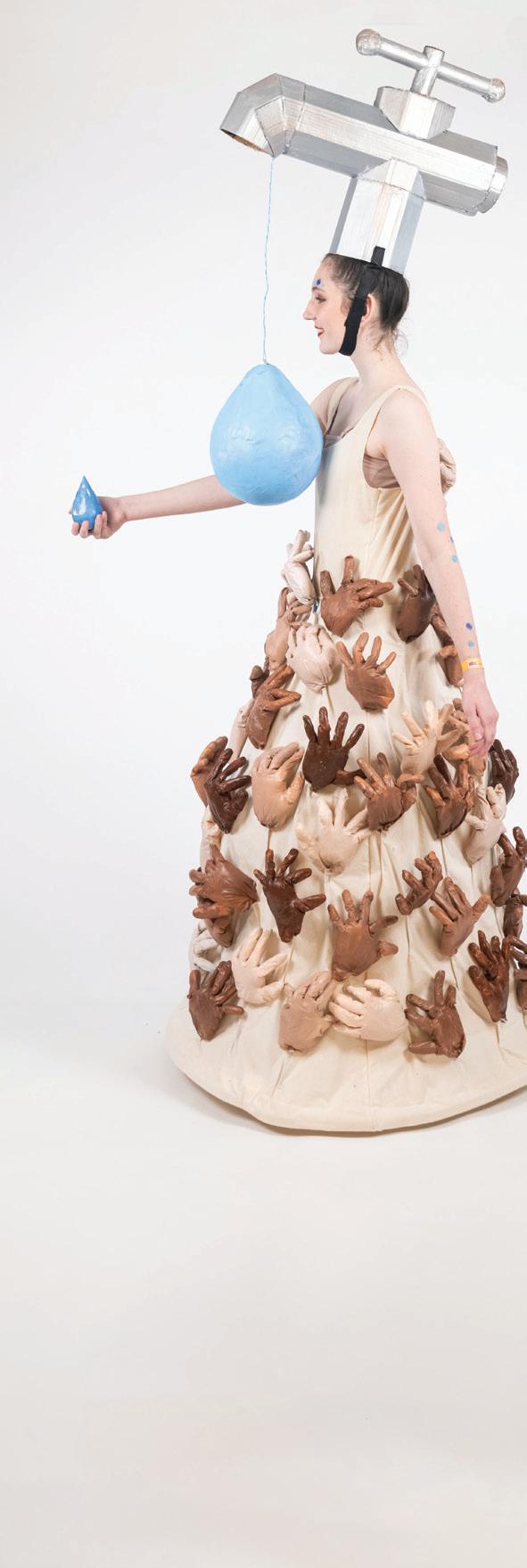
28 August 2023
1 2 3 4 5 6 7 8
Books connect ākonga to past, present and future
The new Connected and inaugural He Kōrero Tātai books explore the rich history of Aotearoa New Zealand and provide a valuable learning resource for ākonga now and for years to come.
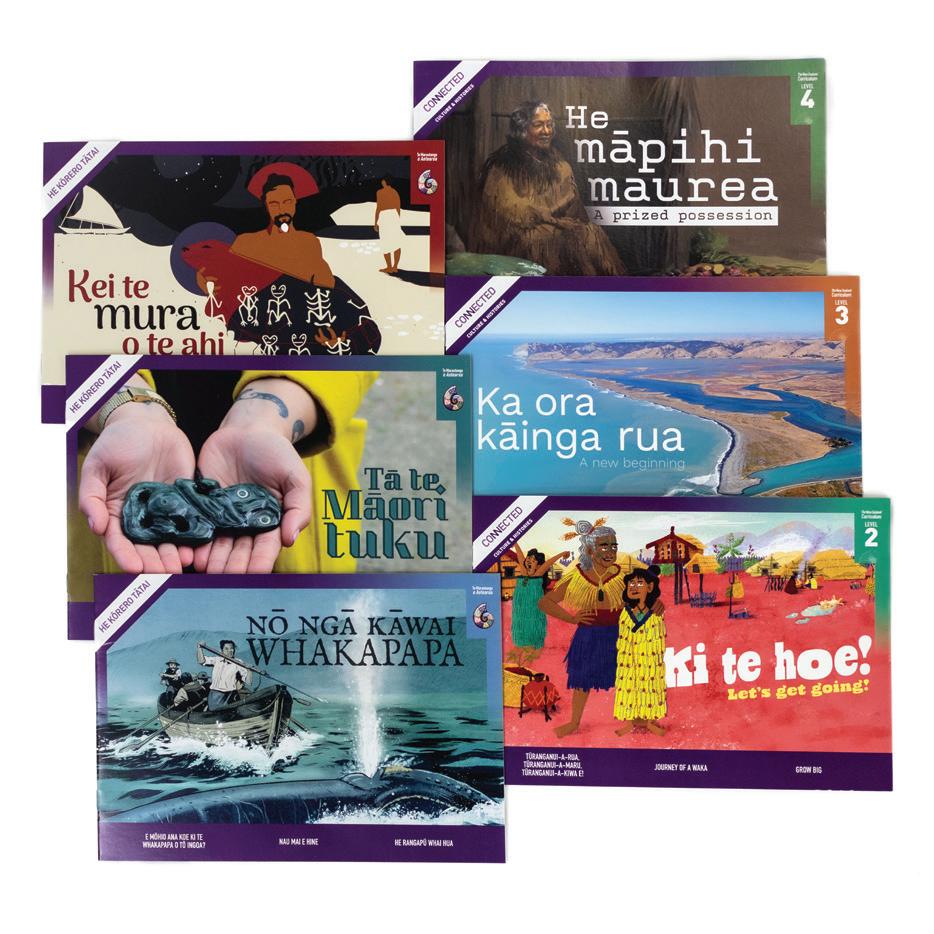
28 Education Gazette gazette.education.govt.nz
HISTORIES RESOURCES
He Kōrero Tātai and Connected book covers 2022.
AMoriori oral history handed down over hundreds of years tells of Ri’i and his family as they prepare to leave for new lands. This story depicts their journey across the vast Pacific Ocean to lands which would become known as Rēkohu Chatham Islands.
Another story is told from the perspective of a rūruhi, a kuia as she waits for ‘The red man’, the future king Te Wherowhero, to arrive at her kāinga. She seeks lasting peace with him through the gift of a precious pounamu.
These are just some of the pūrākau included in 2022 Connected and the inaugural He Kōrero Tātai books developed in te reo Māori.
The books signal a new beginning by bringing pūrākau to light to support Aotearoa New Zealand’s histories and Te Takanga o te Wā.
This year, Te Takanga o Te Wā and Aotearoa New Zealand’s histories became part of the curriculum content for all kura and schools’ marau ā-kura and local curriculum.
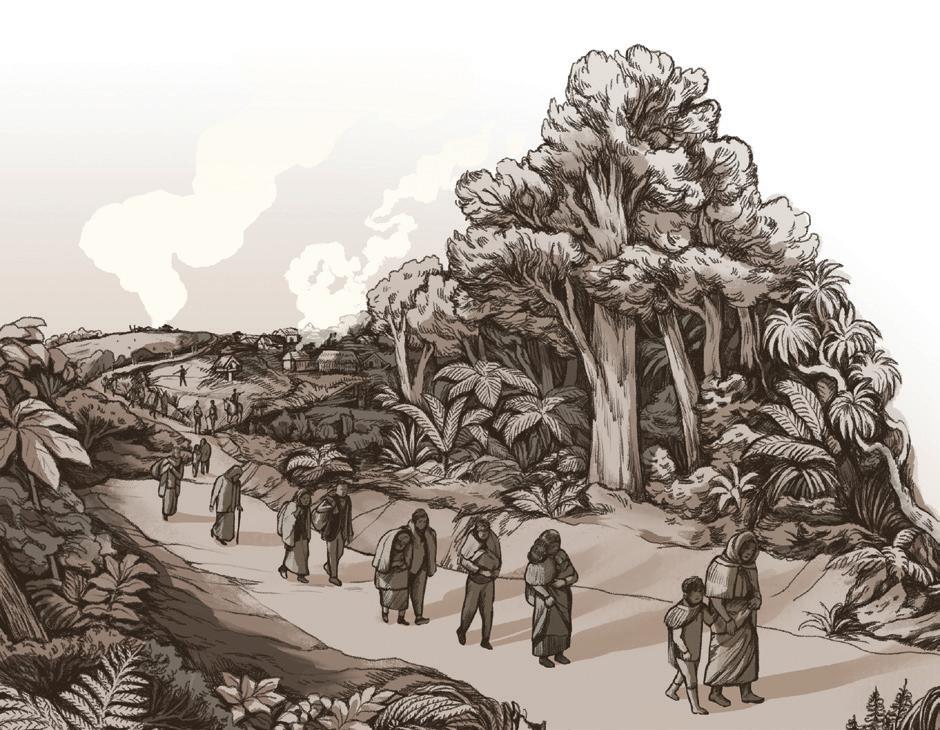
To support this change, the Connected series has now shifted focus from scientific, technology and mathematical literacy (STEM) subjects to Aotearoa New Zealand’s histories and Te Takangā o te Wā (24 editions are still available to support STEM teaching and learning). This reflects work on the National Curriculum to ensure it is fit for purpose now and in the future, and supports the languages, identities, cultures, and wellbeing of all students in Aotearoa New Zealand.
The Connected series has long been a core part of the literacy resources provided by Te Tāhuhu o Te Mātauranga | The Ministry of Education for ākonga in Years 4–8 (curriculum levels 2–4).
These books are set to benefit ākonga now and into the future, with the themes of whakapapa and whanaungatanga in the Connected books, and whakapapa in the He Kōrero Tātai series.
29 Tukutuku Kōrero 28 August 2023
“Te Kāhu Pōkere o Tāmaki Makaurau e kore e ngaro i te hinapōuri”, Kei te mura o te ahi, He Kōrero Tatai, 2022. Nā Matene Karena. Nā Isobel Joy Te Aho-White pikitia.
“He ihu hūpē au i te ao tuhituhi engari e ngākaunui ana au ki te tukanga me ngā tikanga tuhituhi, he wheako nui ki a au.”
Patariki Grace
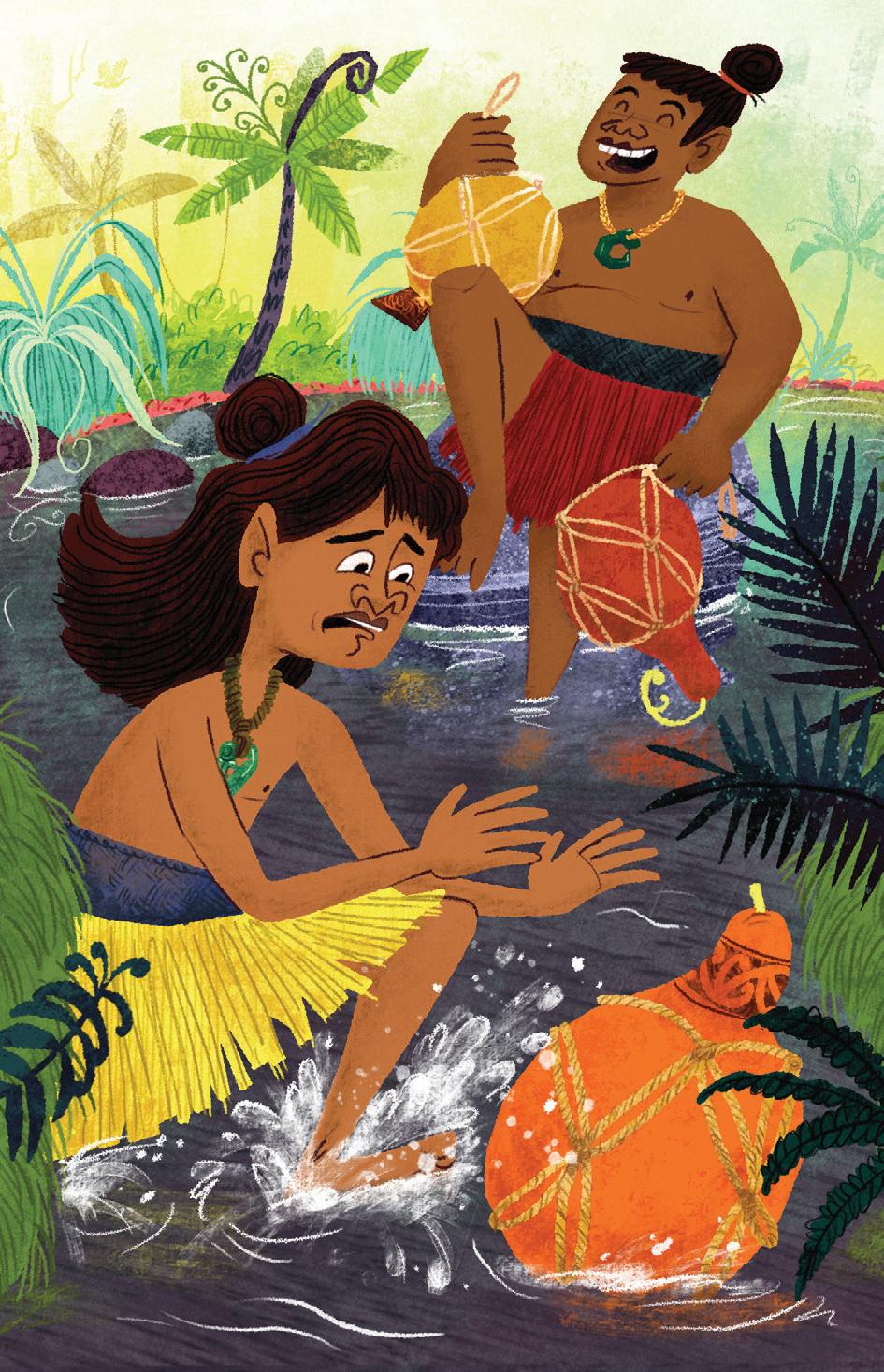
30 Education Gazette gazette.education.govt.nz
“Grow Big”, Ki te hoe!, Connected, 2022. By Paula Morris. Illustration by Josh Morgan.
Taonga for future generations
Connected has been expanded to provide te reo Māori editions with He Kōrero Tātai. The inaugural editions have been developed from te ao Māori perspectives and are not a translation of Connected
These first editions feature articles by Māori authors from around the country, including Patariki Grace of Ngāti Toa and Anahera McGregor of Ngāti Ruanui.
The content provides rich materials for exploring histories and responds to the identities, languages and cultures of all students.
Patariki Grace says it was a privilege to research deeper into a number of tūpuna and events in history, then to write about them from a Māori worldview.
“I reflect about the lack of Māori history taught in the schools I attended when I was a kid – but snippets I heard of in other settings engaged me at a young age,” says Patariki.
“I took this into consideration for one of the stories I chose to tell with the hope to engage ākonga in this day and age and to somehow make a difference in their lives. He ihu hūpē au i te ao tuhituhi engari e ngākaunui ana au ki te tukanga me ngā tikanga tuhituhi, he wheako nui ki a au.”
Anahera McGregor says what they know for sure, and what sits at the very heart of the new curriculum, is that ākonga, whānau and kura want our histories to be taught and learned.
“When historical content resonates with ākonga they are able to connect with who they are and where they have come from. They can be proud of their ancestors and in turn be proud of their identity,” says Anahera.
“The He Kōrero Tātai series recounts feats and experiences in a way that aims to capture hearts and minds.”
A range of kaupapa
As kura, kaiako, whānau, and communities consider the historical contexts that are important to them, having access to a range of resources that support curriculum and their aspirations is important, she says.
The inaugural He Kōrero Tātai series includes fiction and non-fiction texts on the theme of whakapapa. Each text is illustrated and designed to be engaging, accessible and informative for ākonga.
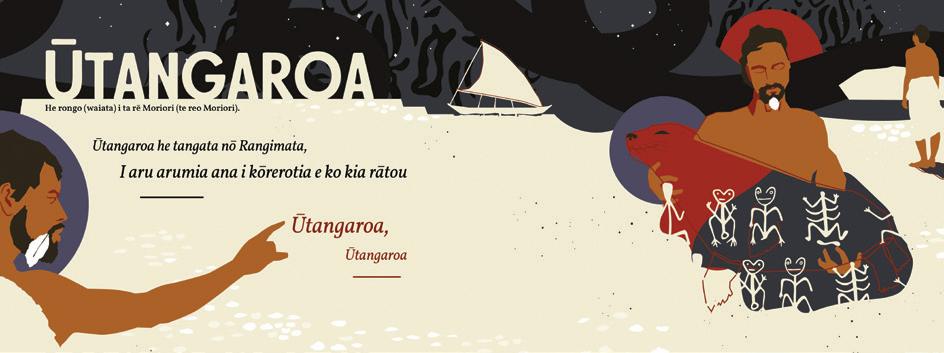
The series was designed to showcase a range of kaupapa that directly relate to Te Takanga o te Wā.
Writers have endeavoured to produce vibrant, relevant, and diverse perspectives and hope that kura might draw comparisons to their own histories, ensuring that stories are shared and retold for generations to come.
Author Paula Morris, a well-known writer and lecturer at the University of Auckland, says that with any story, characters are the most important thing because they have a way of connecting with their audience.
In her short story Grow Big, which features in the Connected level 2 resource, Moka is the point-of-view character and he’s smaller and not as strong as his friend Tai.
“I’m always less interested in characters with superpowers and more in characters who have something to overcome, or characters who have to work harder or use their ingenuity,” says Paula.
“Characters make a story – they’re the starting point rather than a theme or message.
31 Tukutuku Kōrero 28 August 2023
“Ūtangaroa”. Kei te mura o te ahi, He Kōrero Tātai, 2022. Nā Hokotehi Moriori Trust. Nā Johnson Witehira pikitia.
“When historical content resonates with ākonga they are able to connect with who they are and where they have come from. They can be proud of their ancestors and in turn be proud of their identity.”
Anahera McGregor
New beginnings
He Kōrero Tātai
Ko te huinga pukapuka He Kōrero Tātai, he kohinga kōrero e whakatairanga ana i ētahi āhuatanga nō neherā hei ako mā te tamariki te hītori. Katoa ngā kōrero e hāngai ana ki Te Takanga o Te Wā, te marautanga ako hītori hou. E hāngai ana ngā pukapuka
He Kōrero Tātai ki ngā ākonga kei ngā Tau 4–8. Ko te arotahinga o tēnei putanga ko te ‘Whakapapa’, tētahi o ngā tirohanga nō roto ake o Te Takanga o Te Wā.
He Kōrero Tātai is a collection of historical and contemporary texts compiled for students in Years 4–8. The focus of this issue is Whakapapa, one of the tirohanga from Te Takanga o Te Wā.
The new titles of the He Kōrero Tātai series are:
» Nō Ngā Kāwai Whakapapa
» Tā te Māori tuku
» Kei te mura o te ahi
Connected
The Connected books contain a variety of stories and articles that support Aotearoa New Zealand’s histories and engage students to support their reading development.
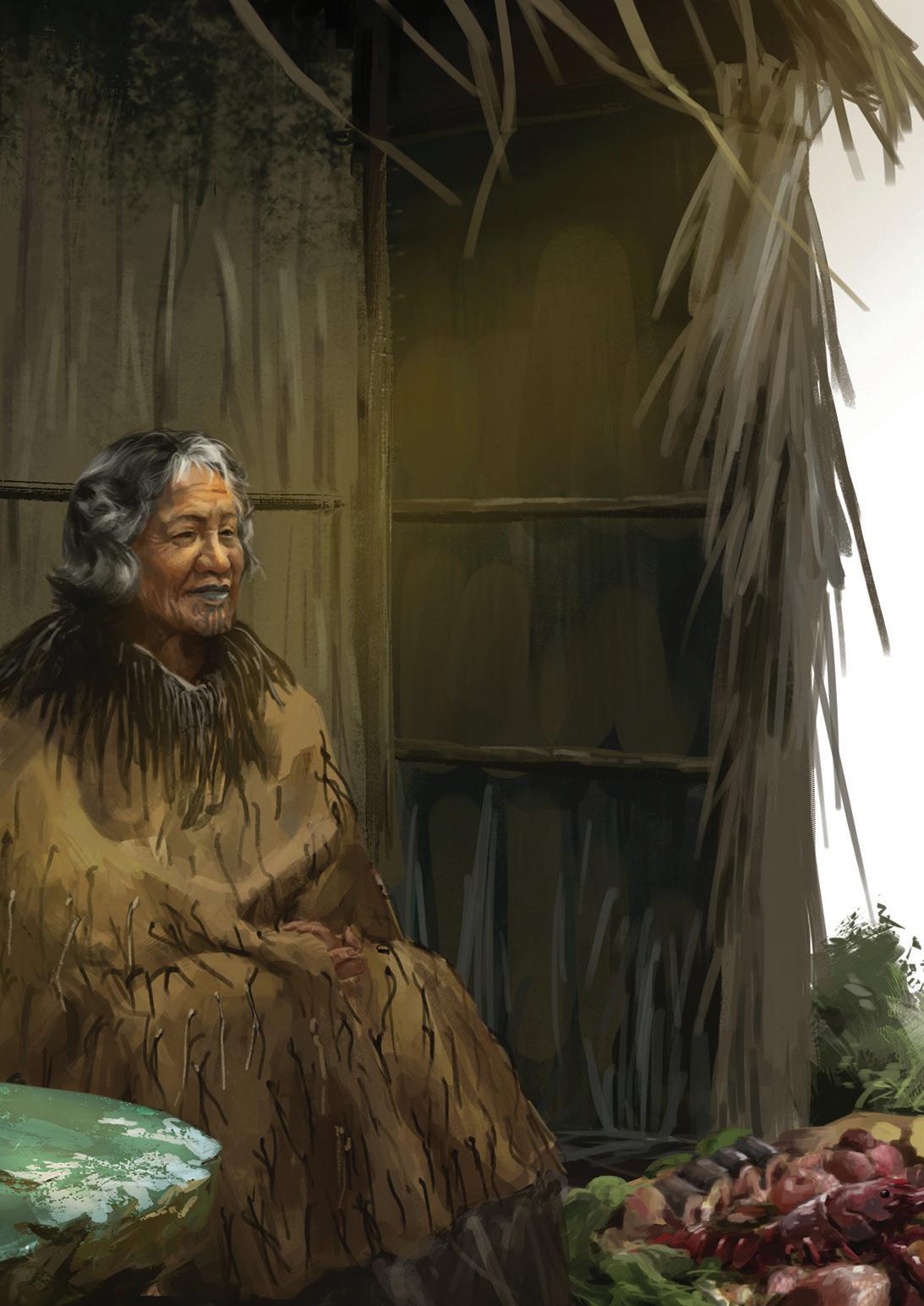
The titles for the new series of Connected books are:
» Level 2: Ki te hoe! | Let’s get going!
» Level 3: Ka ora kāinga rua | A new beginning
» Level 4: He māpihi maurea | A prized possession
With a total of 18 stories, articles and teacher resources in the books, He Kōrero Tātai and Connected provide an avenue for local histories to be told and heard from diverse communities, iwi and hapū.
In addition to the printed books, the material is available online.
Each online book features Google slides of the text and kaiako support materials, audio, and additional digital content for one of the articles in each book.
Schools have received class-sets of Connected and each kura has received class-sets of He Kōrero Tātai. More copies of either publication can be ordered at thechair.co.nz.
“When the Red Man Came”, He māpihi maurea, Connected, 2022. By Ben Brown (Ngāti Paoa, Ngāti Mahuta, Ngāti Koroki). Illustration by Joseph Qiu.
Over $100,000
of STEM
equipment to be gifted to schools
Applications open on Tuesday 5th September and close on Friday 22nd September 2023*
To apply visit: genesisschoolgentrust.org.nz/stem/apply
*Terms & Conditions apply
The Genesis School-gen Trust gifts STEM (science, technology, engineering, maths) equipment to schools to empower students and inspire them to become the next generation of Kiwi innovators.
The Trust was established in 2019 to allow Genesis and its customers to support schools and help students get the skills needed for jobs of the future.
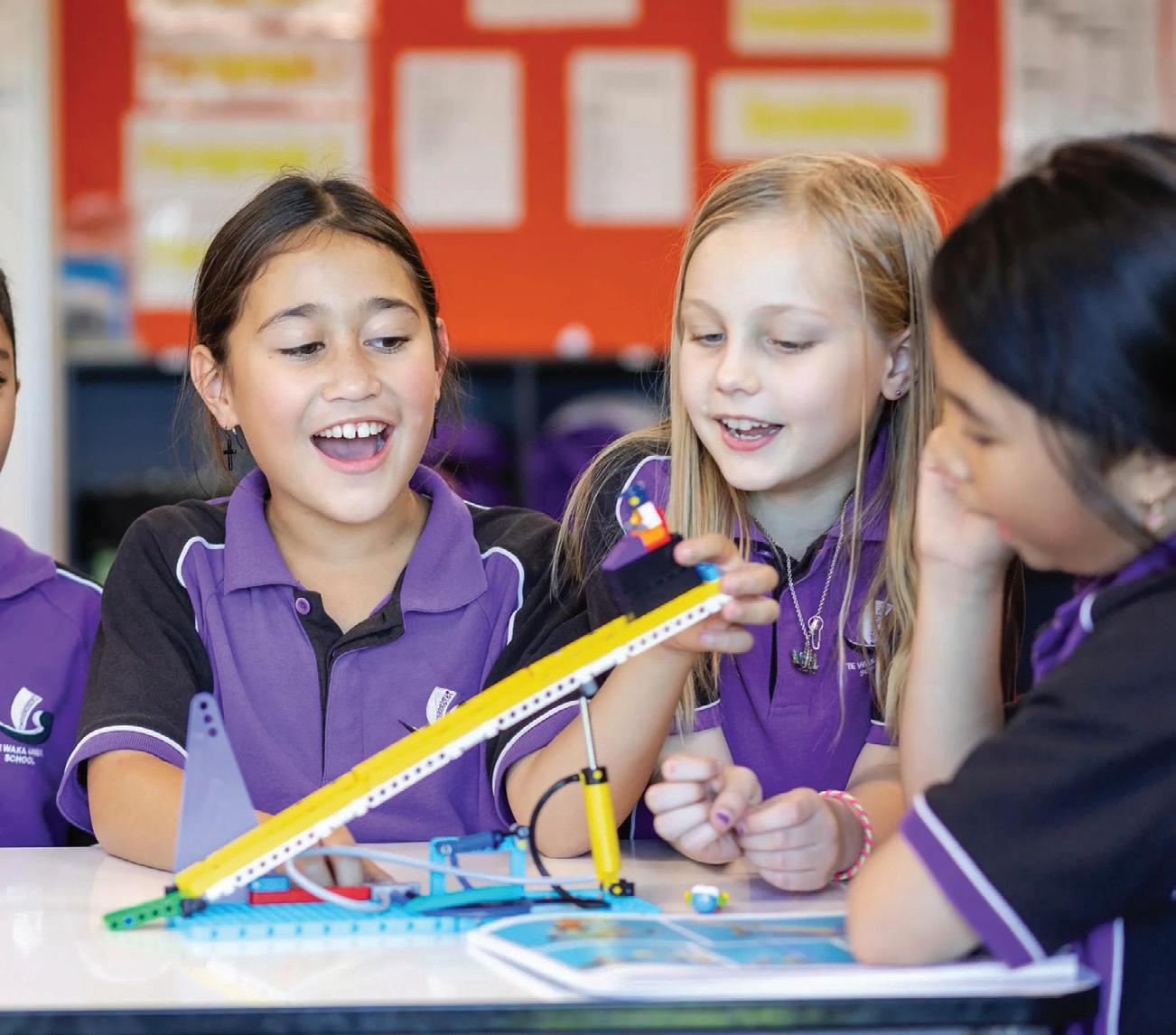
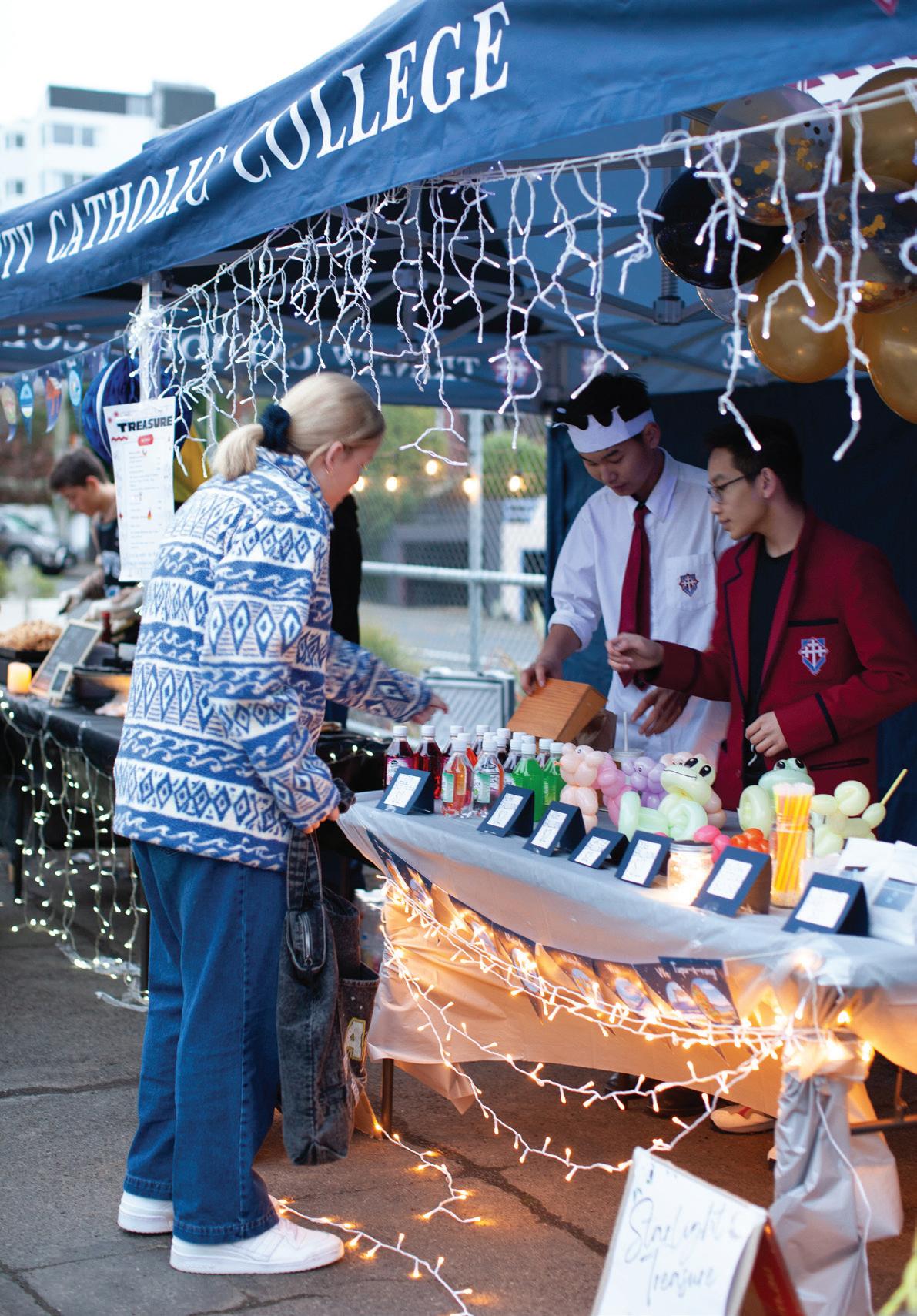 Camera, lights, action! Louis and Lam provide first-class customer service. The balloon animals were popular with all ages and sold out quickly.
Camera, lights, action! Louis and Lam provide first-class customer service. The balloon animals were popular with all ages and sold out quickly.
Cross-curricular approach to Matariki in Te Waipounamu
Two schools in the South Island took a cross-curricular approach to bring Matariki to life for ākonga and their communities – in a local context, and with the true essence of this special time of year at the heart of it all.
What began as an idea to fulfil a NCEA Level 1 commerce programme requirement swiftly morphed into a cross-curricular community Matariki celebration in Ōtepoti Dunedin.
When teacher Jill Armstrong was casting around for an idea to steer her Trinity Catholic College commerce students towards, the stars aligned –nine in particular: the Matariki cluster.
Jill’s Year 11 class had to design, evaluate and refine a business activity that incorporated a community wellbeing focus.
“They needed an outlet – a localised, real-world context and I thought Matariki was a natural fit.”
Night stalls
Students were tasked with creating Matariki-inspired products and activities fit for a community night market.
Jill says, “I guided them through the business theory and then they chose their groups and managerial roles and did their own learning. It worked a treat.”
Some made prototypes of their products (stellar biscuits, friendship bracelets, star-studded light jars, face paint designs) while others planned a range of kai stalls. One group catered to Dunedin’s midwinter conditions by making wheat bags to heat and pass out to the less weather-stoic attendees.
Jill says it was a student-led initiative from the get-go.
“I wanted to empower students so they could run the event. I tell them about the ‘Ps’: passion about your product and the people you work with, planning, preparation, priorities, promotion, precision, presentation and provision for others (each group is donating some profits to local charity St Vincent de Paul).”
While the event was focused on celebrating Matariki, students had a valuable range of educational opportunities and soft-skills development.
“It was full of learning for them. It’s like putting spinach in everything without kids knowing. They did soft skills as well – key competencies like leadership and managing self. It instilled a sense of ownership and pride in the event.
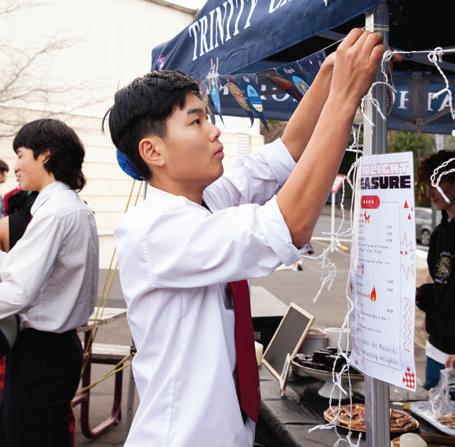
“There’s a saying that I like: although you stand in front of the students, you’re really standing behind them, guiding them. It’s a high trust model.”
Stepping away from the candy floss machine’s whir, Therese oversees her team’s market stall. Showcasing a delectable array of blue and pink spun treats, the alluring scent attracted a steady stream of eager customers.
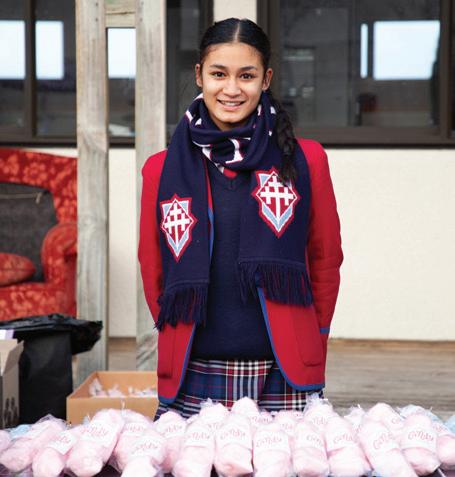
35 Tukutuku Kōrero 28 August 2023
Louis performs a final lighting check before darkness falls.
MATARIKI
A snowball effect
Once Jill spread the word among her Trinity colleagues, her Matariki initiative snowballed into something more multi-dimensional: a night market and a showcase.
The latter was a free event that included kapa haka performances, dance routines, poetry recitals, songs, and a wearable arts parade (Matariki-inspired designs on upcycled T-shirts).
A small concept that initially involved 25 commerce students grew into a vibrant event involving 140 Trinity ākonga.
Jill says, “There’s been some great student pastoral support with the older ones helping the younger ones, so you’ve got the sharing – the tohatoha.”
She built a team of colleagues from languages, commerce, technology, and the arts departments to lead in their specific fields.
Jill says it was vital to have a strong group familiar with
te ao Māori. This latter cohort consisted of te reo Māori kaiako Maya Tate-Manning, Māori/Pasifika dean Amelia Bresanello (Kāi Tahu) and Pesamino Tili, teacher of junior te reo Māori and co-director of religious education – a man who spent the night darting between the kitchen (where he made his much-loved parāoa parai/fried bread) and the stage (where he led the kapa haka group).
Together, they steered the event’s tikanga and safeguarded the essence of Matariki.
Catholic values and te ao Māori
During the planning stages, the team sought feedback from a whānau hui and consulted their school Kaumātua, Justin Hanning (Kāi Tahu) on how to best celebrate te ao Māori within Trinity’s Catholic framework.
“I asked Justin if we could do a Matariki karakia in the showcase and his advice was to just reframe it slightly by doing a mihi to the stars (like a little haiku to each whetū)
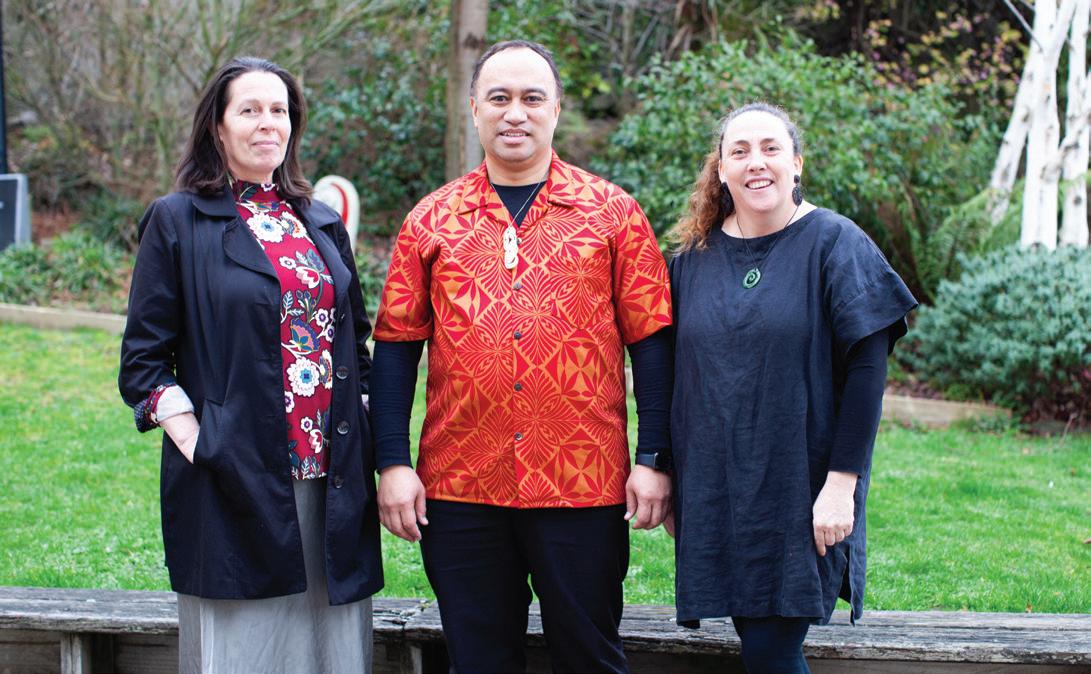
36 Education Gazette gazette.education.govt.nz
“Everything has to be reflective of our special character in mind but we have a Kāi Tahu Kaumātua leading us through the whole journey of working with whānau to make sure we are very inclusive.”
Kate Nicholson
Maya Tate-Manning, Pesamino Tili, and Amelia Bresanello are all set to support akonga during the showcase.
and then that’s respectful to both Catholic Christian beliefs and traditional Māori beliefs,” Maya says.
Pesamino adds, “Kaumātua Justin understands those two worlds and how to integrate them to maintain the integrity of both sides. It reinforces the essence of the fourth article of Te Tiriti – that our Catholic beliefs and traditional Māori spiritual practices need to be respected.”
Trinity’s principal, Kate Nicholson, is keen to continue developing the school’s cultural competency.
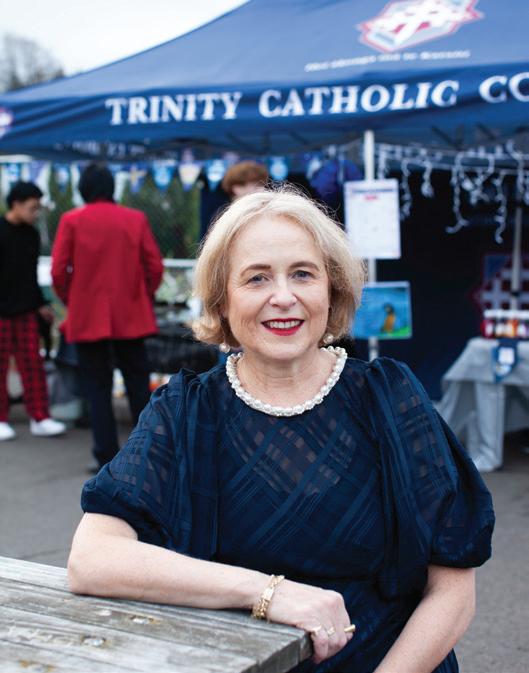
“Everything has to be reflective of our Special Character in mind but we have a Kāi Tahu Kaumātua (Darren Rewi) leading us through the whole journey of working with whānau to make sure we are very inclusive of their wishes,” she says.
Community building
Trinity’s Matariki event attracted a wider range of whānau into the school.

Kate says, “There were families here who may not come to parent-teacher interviews or formal prizegivings but will come to this type of event, so it’s a great way to engage with them.”
Trinity also extended invitations to the eight schools within the Dunedin Catholic Schools Kāhui Ako to unite the wider community in a celebration of Māori culture and to strengthen the whanaungatanga.
Jill says the event was a resounding success on all levels. Whether it was Pesamino’s fried bread or Jill’s hidden spinach that made it so, is a moot point.
Ākonga voice
Oliver Lodge, pianist, Year 12
“I enjoyed the process of researching and learning new waiata. I initially thought there weren’t many Matariki songs but after communicating with Whaea Maya I was able to think a bit wider about other aspects of Matariki, such as the environment and gained a deeper understanding of the bigger concept of Matariki.
“I’m proud of how members of our school community shared their gifts and talents to create a school celebration centred around Matariki. Teachers and students have worked together to come up with ideas, and because of this, it feels unique to our school. This is only the second year that Matariki has been a public holiday and I hope the event builds a feeling of inclusiveness and celebration of Māori culture.”
Leah Olsen, economics student, Year 10
“My involvement in the event was designing a Matariki T-shirt. I learned a lot about the history behind the stars and what Māori use these stars for. As a child, I didn’t celebrate or understand Matariki, but as I grew up, I understood how important it is for Māori. I hope the event will unite people to celebrate this important holiday.”
Che McGivern, economics student and saxophone player, Year 10
“My band members and I discovered the depth and variety of Māori music and how we can play it as a band. I hope the event will raise awareness of Matariki and how Māori music and culture can be integrated into our school community.”
37 Tukutuku Kōrero 28 August 2023
With pride, Jill Armstrong observes as the Year 11 commerce akonga skillfully arrange their vibrant market stalls..
The Matariki-inspired star-studded light jars take on their own magic as darkness falls.
Adapting a Matariki celebration to reflect the local environment
Inspiration for a whole-school Matariki production at Oaklands Te Kura o Ōwaka came from the school’s cultural narrative so the event celebrated both the whetū and their local marae and environment. The play incorporates local karakia, haka and waiata and acknowledges local flora, fauna and landmarks.
The Stars of Matariki is a fantastic school production written by Dave McMillan (2021), set on a North Island marae. When Oaklands Te Kura o Ōwaka deputy principal Caroline Martin was researching an appropriate schoolwide Matariki celebration, she found the McMillan production and knew it fitted their bill. But to be authentic for their ākonga it had to be adapted for their Canterbury location.
Ahead of the school’s post-earthquake rebuild, completed in 2021, Te Taumutu Rūnanga gifted the school its cultural narrative.
So, it was natural for the school to set the play’s adaptation at Ngāti Moki Marae at Taumutu on the shores of Te Waihora Lake Ellesmere.
While the story focused on the Matariki cluster and the stars’ meaning, the setting and storytelling was adapted to their local environment.
“The cultural narrative was represented subtly in the waiata we chose. The haka that the children performed was the one that we had been taught by the Rūnanga. We incorporated the symbolism and design from the marae carvings, and we talked a lot about the plants and animals, the living aspects of our cultural narrative, in the story as well,” says Caroline.
It was important to weave Matariki and their cultural narrative together while honouring both.
The script was shared with Te Taumutu Rūnanga and their advice and guidance was valuable and appreciated, says Caroline.
“We wanted to acknowledge the significance of Te Waihora as one of the largest breeding grounds for birds in the world. We brought that into the script by including some bird watchers who were looking at birds on the lake. When we were thinking about the backdrop and everything for the set, we used the Port Hills and the local landscape as well as mirroring the carving designs that can be found on the marae,” she says. “There was a lot of learning that went into that for the children.”
A cross-curricular event
The production was a true cross-curricular event – history, literacy, art and creative design, te ao Māori and science –and involved a lot of problem solving.
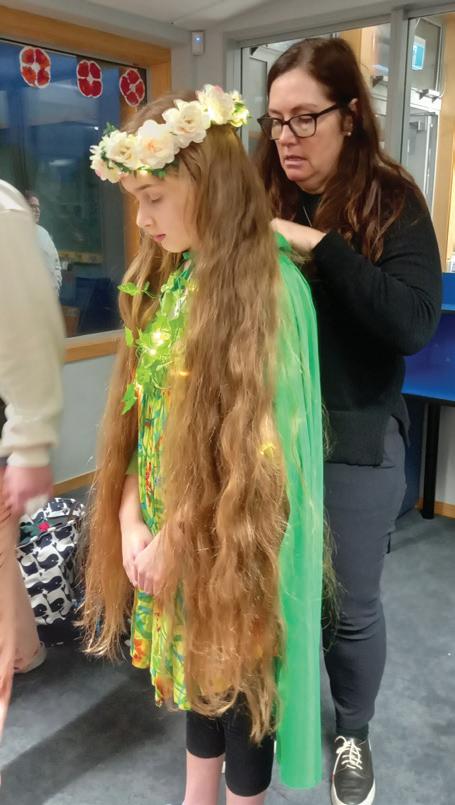
Oaklands Te Kura o Ōwaka has transformation as its curriculum theme for the year and the teaching team wanted the production to reflect the positive changes the school has experienced in recent years with its rebuild and the transition to collaborative teaching and learning.
The school’s science focus for term 2 was ‘Light and Sound’, and that also fed into the production content as the children designed props and costumes featuring LED lights and a lot of glow-in-the-dark paint.
Each area of the school performed a particular aspect of the story, and every one of the 600 children was involved over three nights.
Students were in awe of each other’s creativity and there was a lot of mentoring happening between the older and younger children, Caroline says.
Parents’ feedback focused on how much te ao Māori they had learned from the performance.
Now the drops of fluorescent paint in unexpected places around the school are a reminder of a wonderful production.
38 Education Gazette gazette.education.govt.nz
Olive preparing for her performance as Papatūānuku.
Whole-school involvement
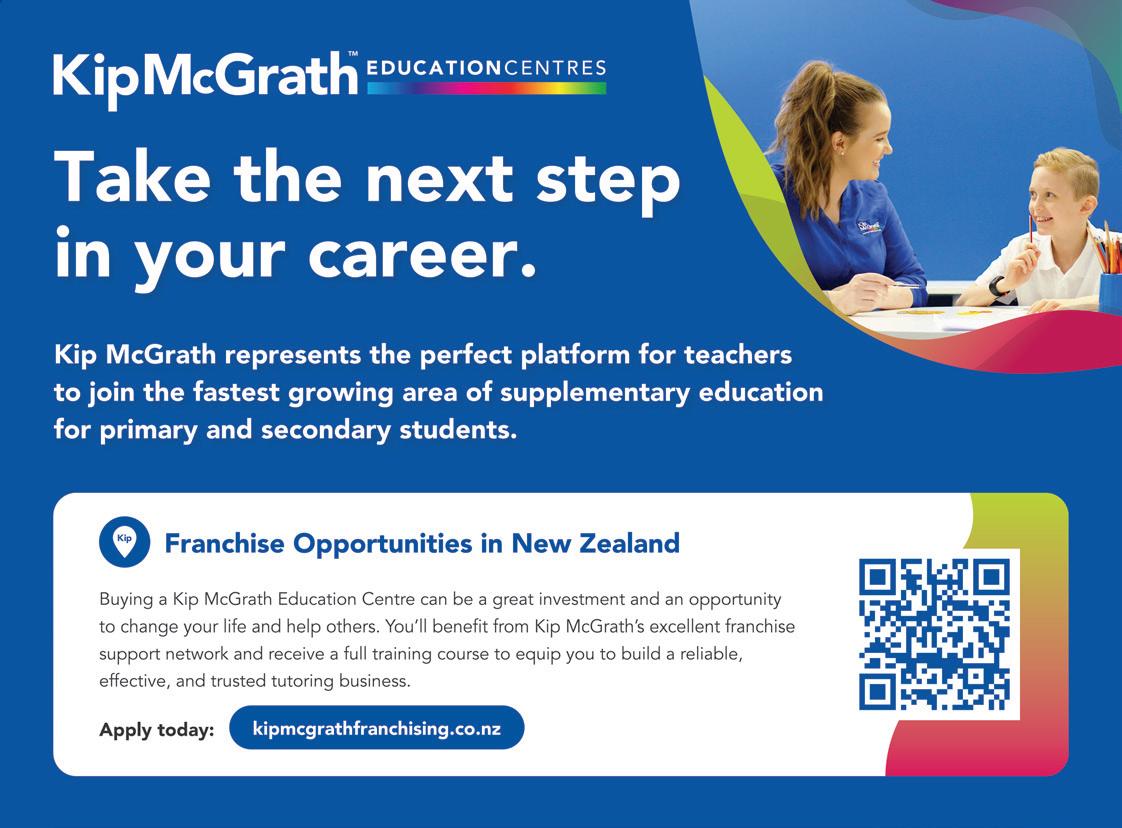
» Year 1 students created glow-in-the-dark poi and taiaha to perform in the pōwhiri.
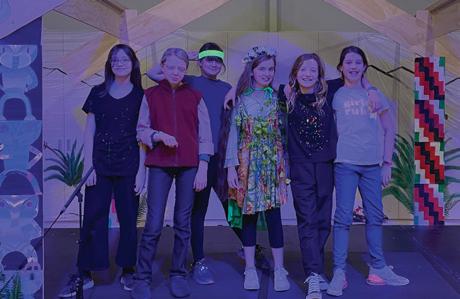
» Year 2 students designed instruments to re-enact a storm sequence.
» Year 3 students created costumes and fluorescent stars.
» Year 4 students told the story of each star in the cluster.
» Years 5 and 6 students used their knowledge of electrical circuits to create kites that lit up the night sky.
» Years 7 and 8 students demonstrated strong leadership and were actors, set designers, or lighting and sound technicians.
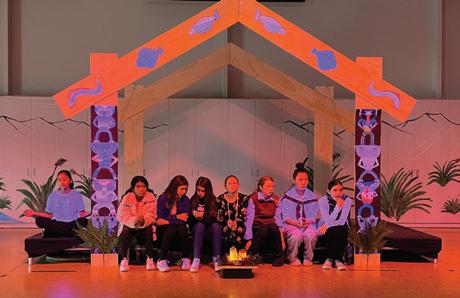
39 Tukutuku Kōrero 28 August 2023
The set was designed to reflect the landscape of Te Waihora.
Some key characters at Ngāti Moki Marae.
Electrifying cross-curricular education
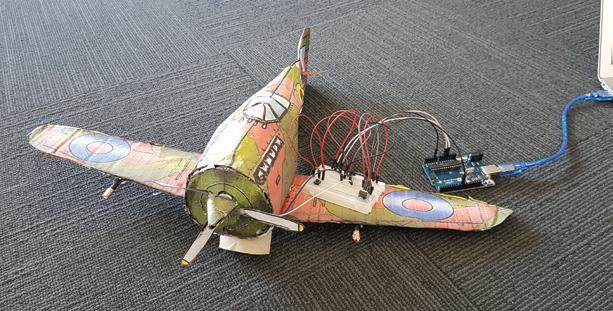

Two Nelson teachers are using resource kits to enrich learning within their schools and set ākonga on a path to success within the curriculum and future career pathways.
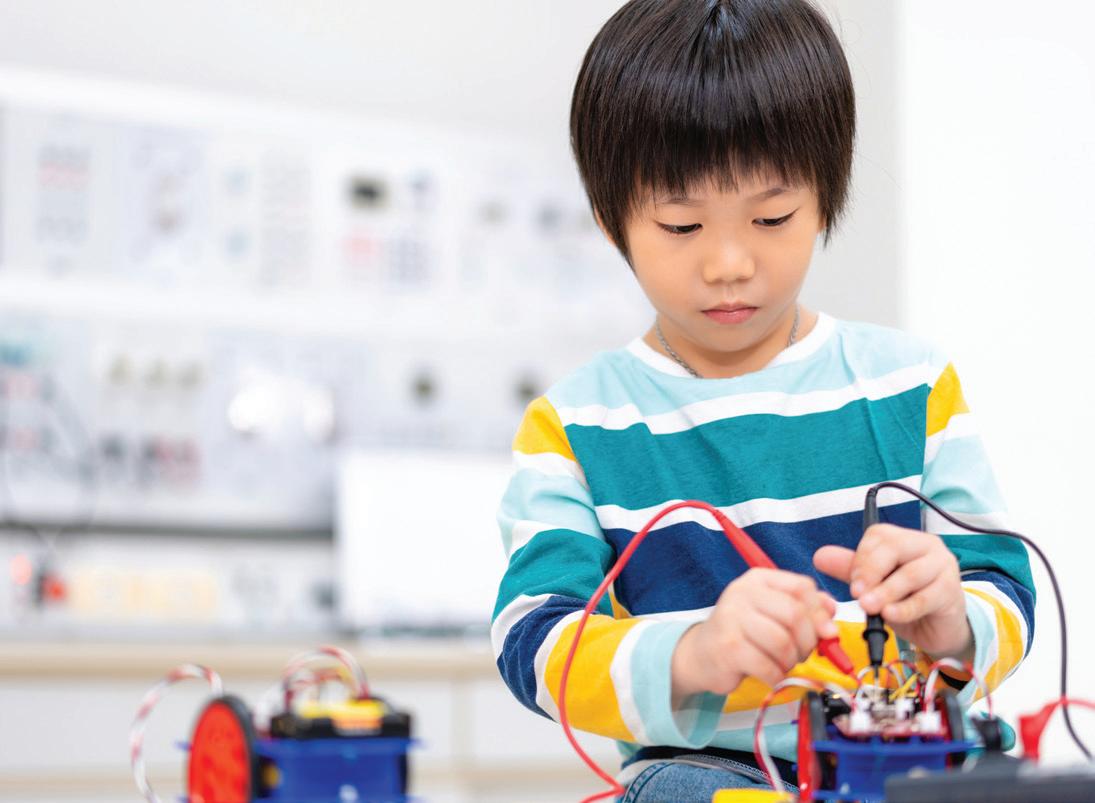
40 Education Gazette gazette.education.govt.nz
TECHNOLOGY
All the images in this article show ‘creativity, coding and electronics’ projects, supplied by St Joseph’s School in Nelson.
Apassion for technology teaching led Vince Fox back to the classroom after a retirement false start – and he’s passing this passion on to future generations by introducing electronics to young minds.
Term 2 saw a hive of tech activity for Vince’s Year 9 students at Tapawera Area School. He taught students some generic electronics concepts and set them off on self-managed learning tasks using kits, remote-controlled cars and Lego.
“The pre-set lessons within the kits we used allowed the students to take charge of their learning, self-managing their way through the activities and exercises,” says Vince, who has been teaching at the area school for over seven years.
“They experienced a sense of achievement when successfully assembling the components and witnessing their functionality. In moments of uncertainty, students actively sought assistance from their peers, fostering collaboration and teamwork.”
The STEAM kits were one of three electronics-based activities Vince engaged students with throughout the term. Lego Mindstorm electronics packages and tiny remote-controlled cars were the other modes of learning about the essentials of electronic engineering. Not only did they have fun with these activities, but they also got the students moving – in body and mind.
“I got ākonga active,” says Vince. “We had done some front loading on the basics of electronical concepts, so that when they were let loose on the activities, they had an understanding and could get stuck in.
“This involved plenty of moving around, physically, as well as mentally figuring things out. I had to try to stand off, as best I could, as the intention was that this part was self-taught.”
Pre-learned knowledge
Vince ran the programme for three lessons a week over what turned out to be rather a disjointed term. This impacted on the final stages of the work and the
evaluation process, during which he had hoped to be able to link the learning to Te Mātaiaho | the refreshed NZ curriculum. However, much was learned, and enjoyed, says Vince.
“An important lesson for students was the significance of following pre-learned knowledge, rather than randomly assembling components. This was exemplified in a lesson where an LED was intentionally meant to blow as part of the learning process!
“They were saying, ‘it’s not going, it’s not going’. It was a test, to see if they had read the rest of the instructions. It was all part of the learning.
“They had to show they could fault-find and they learned how to use a meter. I hope to get even further along and extend the learning with the next Year 9 group,” says Vince.
STEAM kits
Not-for-profit organisation Ministry of Inspiration produced the STEAM kit (the brainchild of Alan York and Amy Cornelisen) that Tapawera Area School used as part of their electronics programme.
The compact kit contains the necessary materials for learners to work through lessons themselves, with minimal teacher input.
“I’ve always been an advocate for The New Zealand Curriculum,” says Vince. “I believe it was well-written and forward thinking for its time. The refreshed curriculum will have some new aspects that I will be able to bring in to increase students’ skills and knowledge.”
He plans to explore the more advanced features of electronics with his next year group, by building on his work using the kits.
“I found these effectively introduced and engaged students in activities that apply their acquired knowledge and skills to solve real-world challenges within the materials technology field. The hands-on nature enhances student learning outcomes and deepens their understanding of the subject matter.”
41 Tukutuku Kōrero 28 August 2023
“The pre-set lessons within the kits we used allowed the students to take charge of their learning, self-managing their way through the activities and exercises.”
Vince Fox
Tech meets Harry Potter
Across the Nelson District, electronic exploration has also been a feature at St Joseph’s School.
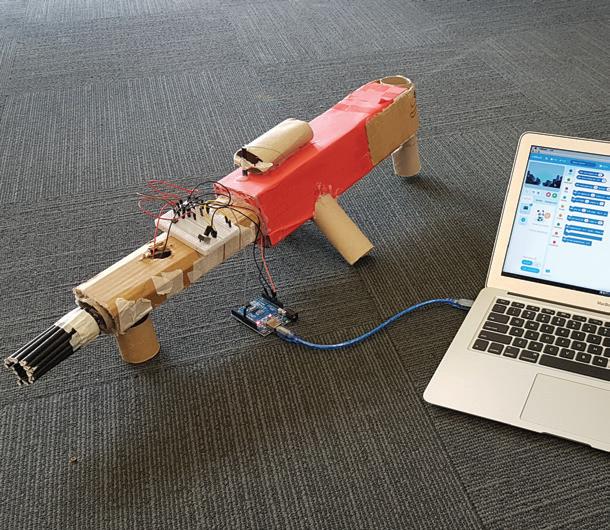
Teacher Antonio Sardella introduced a talented group of Year 4–8 students to the fascinating world of creativity, coding, and electronics.
Unleashing bright young minds on self-directed projects, with the use of kits, “students eagerly embraced the challenges they presented”, says Antonio.
“We had a really talented group who were really into Harry Potter, and they made a replica Hogwarts Hall. It had LED lights in yellow and orange that they had made to look like candles flickering, as well as a broomstick that rotated around a tower. It was impressive stuff!”
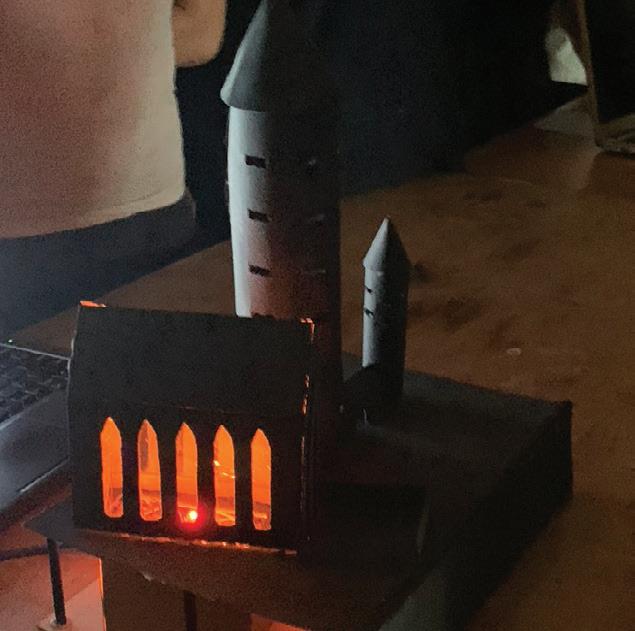
Adapting, reflecting, and overcoming challenges was a key part of the learning.
“While some students struggled with resilience when hitting bugs, it is important to note that younger students, such as those in Year 4, surprised us with their resilience and ability to navigate through the lessons. Ultimately, we found their success largely depends on the students’ motivation, drive, and personal interest in coding and electronics.”

A focus on science
As an educator, Antonio appreciated being able to gain a comprehensive understanding of each lesson and its objectives through an educator handbook.
“This empowered me to effectively support my students and enabled me to pass on accurate information and troubleshoot effectively too,” he says.
The focus for Year 5–8 students at St Joseph’s School in term 3 is science. This will culminate in an upcoming area science fair, which will see the school pit its skills against others in the region.
“We ensure that every aspect of our learning comes from a topic that we focus on for the term,” says Antonio.
“We have been teaching about the scientific process; gathering, analysing and using data, and integrating maths and English into this, too, as it all helps when it comes to both researching and presenting their science projects.”
A teacher at the Nelson school for six years, Antonio is mindful of taking a slow and steady approach to linking past and present learning into Te Mātaiaho | the refreshed NZ curriculum.
“We’ll be able to tie a lot of aspects of the refresh into our learning,” he says.
“But right now, we are trying to wrap our heads around all the new elements and giving information to students so they can set themselves up for success, as opposed to making too much change too quickly and risk setting them up for failure.
“That is why we are delivering integrated unit style teaching to bring related subjects into our science learning.
42 Education Gazette gazette.education.govt.nz
“Connecting lessons to real-world applications enables students to develop a deeper understanding of the relevance of the skills and knowledge. Furthermore, the open-ended nature of the projects they engage in encourages critical thinking and fosters creativity.”
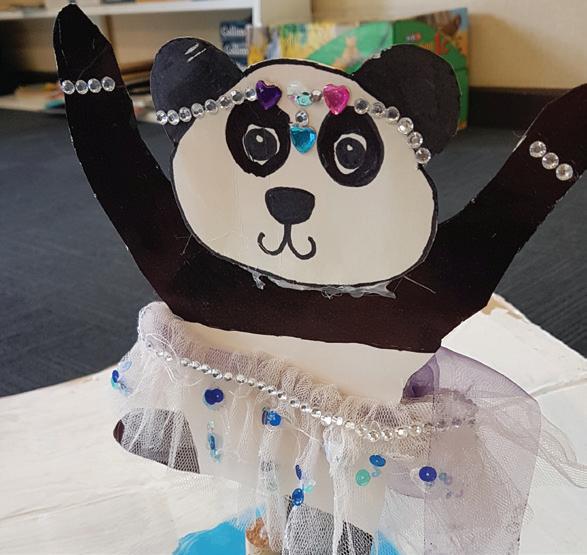
Advice for kaiako
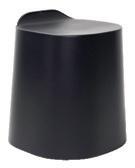
Antonio says he would suggest the use of resources such as kits to educators seeking to incorporate coding and electronics into their curriculum.
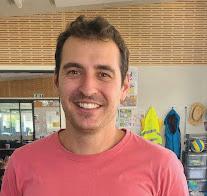
“They may find they are suitable for a range of age groups, although older students tend to benefit more, due to the fine motor skills and patience required to complete each lesson successfully.
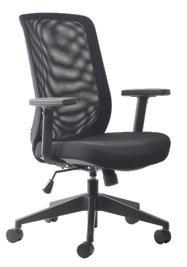
“It is always important to consider the students’ age and level of motivation, drive, and willingness to tackle challenges when determining the appropriate audience for any lessons.”
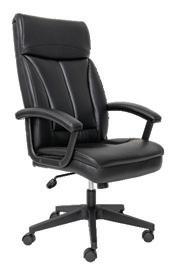
43 Tukutuku Kōrero 28 August 2023
“Connecting lessons to realworld applications enables students to develop a deeper understanding of the relevance of the skills and knowledge.”
- BRANDING LOGO FONT - Mark Pro-black use
Pro Medium for catchy headlines COLOUR SWATCHES SMART GREEN = C=50% M=10% Y=30% B=0% CMYK CMYK SMART GREY = C=80% M=55% Y=60% WEB COLOUR = #81BCB6 R=128 G=188 B=182 WEB COLOUR = #2B4545 R=43 G=69 B=69 Preferred logo placement Standard version
Antonio Sardella
St Joseph’s School teacher Antonio Sardella.Smart Office
Mark
Former cold storage supplier builds warm classrooms
Annaliese Michel, director of Modcom, tells the inspiring story of how a small Tauranga-based business that supplies cool stores has ended up providing warm and safe learning spaces for tamariki.
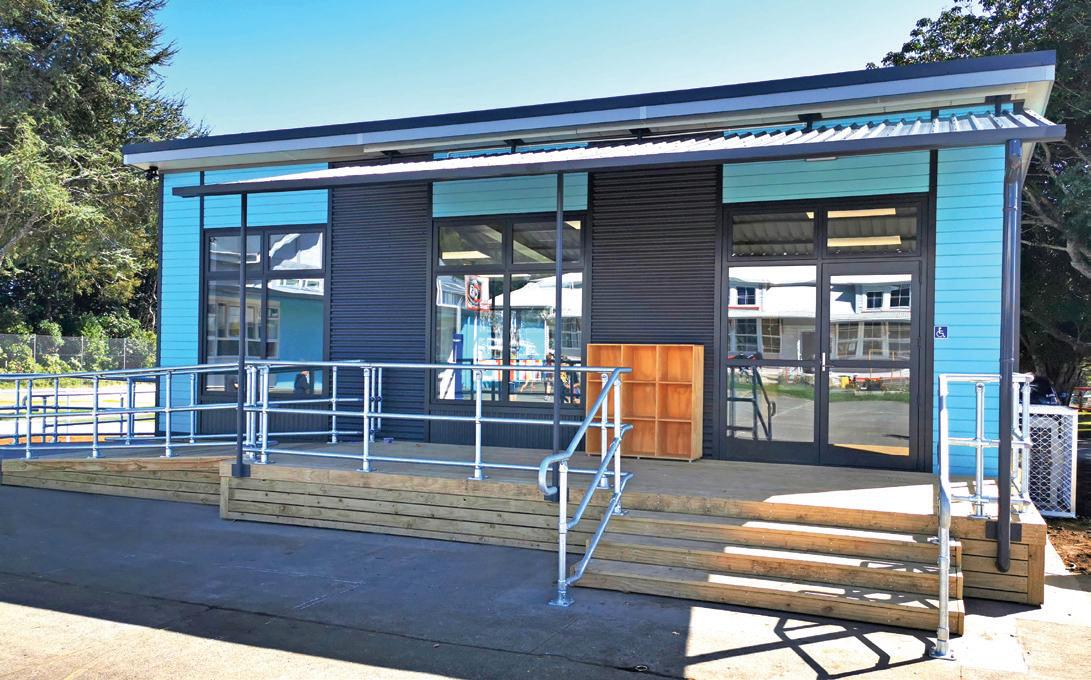
For more information about OMBs, visit education.govt.nz/modularbuildings
The search for a practical waste management solution for their thriving family-run storage solutions business 25 years ago marked the beginning of Modcom’s journey in the field of offsite manufacturing
“My father, Rex McIntyre, established Modcom in 1998 as a supporting entity to our cool store and packhouse construction business. It started as we often had materials left over – and rather than sending them to landfill we used them to make buildings,” says Annaliese.
During their early years, the team worked in a small factory where only two classrooms could be built simultaneously. Their builders worked with a two-metre gap between the structures in progress. In 2019, they were able to move to a
bigger workshop – and now, they operate in a huge purpose-built factory that can cater to the Ministry of Education’s growing requirements for offsite manufactured learning spaces.
Modcom was recently appointed to the Ministry’s panel of pre-approved OMB suppliers who support the Ministry to deliver their programme of work.
While the company has already been supplying temporary classrooms and ablution blocks for the education sector since 2002, this achievement is a game-changing opportunity for them and for their community.
“Being on the panel is empowering for our team and we are excited for our future growth and development,” says Annaliese.
“We have been able to take more of our contracted workers
44 Education Gazette gazette.education.govt.nz
INFRASTRUCTURE
A single teaching space at Vogeltown Primary School in New Plymouth built using the offsite manufacturing delivery method.
on full-time. This continuity of work enables them to better support their families. We also utilise local subcontractors both within our factory and on site, and this increase in work volume will enable them to grow their businesses and that money will feed back into the local economy.”
Supporting other local businesses is important for Annaliese, and it’s something that she hopes everyone else would consider.
“That spend makes a real difference in people’s lives – it can mean more employment and educational opportunities.”
If at first you don’t succeed, try again
Making it to the panel was quite a journey requiring perseverance and hard work for Annaliese’s team.
“We tried to join the panel the last time it was opened, but we were unsuccessful. So, we spent the last three years addressing our shortcomings to ensure that when the next opportunity presented itself, we were ready,” she says.
In their second attempt to join the panel, Annaliese was pleasantly surprised to see how the Ministry’s procurement team has also worked on improving their engagement approach, which made the experience more meaningful.
“They made the journey feel like a true partnership. Our experiences, comments and ideas were welcomed, validated and supported,” she says.
“In this most recent engagement we had with them, we saw real change to the offering and truly felt like we are all on the same team collaborating to deliver quality educational spaces to schools in need.”
More than just a business
It is the reality that most, if not all, businesses are established for profit so that the owners and their workers can make a decent living. Annaliese, however, would like hers to achieve more than that.
“I’d like to think of Modcom as a service that fulfills a need in our community. I need job satisfaction that we are achieving something more than making money – and the experience of working with the education sector does that,” she says.
“It is very humbling to get letters from children saying how much they like their new classrooms. It is important to us that our buildings are a part of the school and don’t just look like they were plonked there with no thought.
“We put a lot of thought and effort into the functionality of our layouts when installing to make it work best for the school and be least intrusive. We care that we supply quality teaching spaces and ablutions and that our installations meet the needs of the school and the Ministry.”
Many small local businesses tend to pass up government contracts because it has always been associated with onerous requirements and processes. For those who are keen to give it a try, Annaliese has a piece of advice.
“Don’t be scared by the amount of information that is required – just tackle the RFQs one question at a time. You probably are doing a lot of what they are asking but haven’t ever formalised it. Talk to other companies that are working on government contracts.”
About OMBs
Offsite manufacturing is one of the Ministry’s newer property delivery methodologies where learning spaces are built and assembled off site, and then moved onto the school grounds once ready for installation.
Buildings that have been manufactured using this delivery method are built to the same standards as permanent school buildings and reflect modern teaching environments. They can be delivered in a shorter time frame than traditional classrooms, with less disruption to school activities.
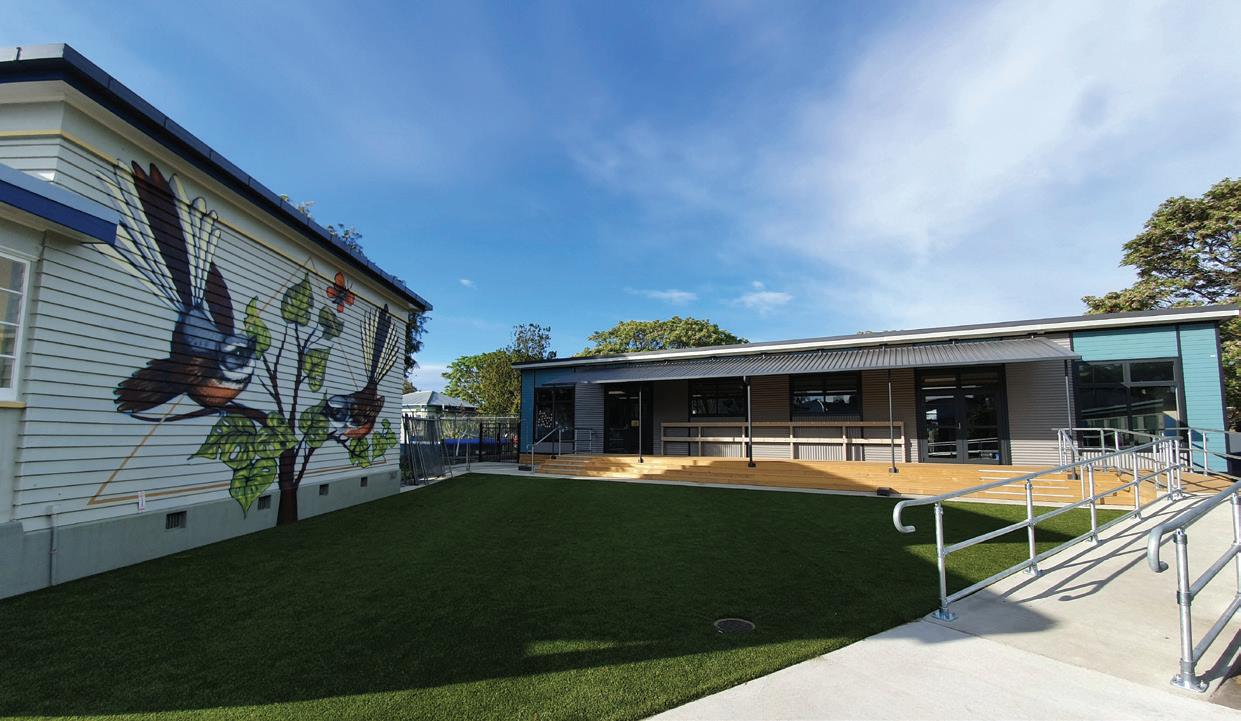
45 Tukutuku Kōrero 28 August 2023
Built to the same standards as permanent school buildings, this beautiful teaching block at Nelson Park School in Napier was delivered with minimal disruption to school activities.
HEALTH AND PHYSICAL EDUCATION
Re-thinking school events to lift engagement
Primary and intermediate schools across Taranaki are re-thinking their approach to traditional physical activity events and seeing more students engaged and enjoying themselves as a result. Chris McLean from Sport Taranaki explains how, and why.
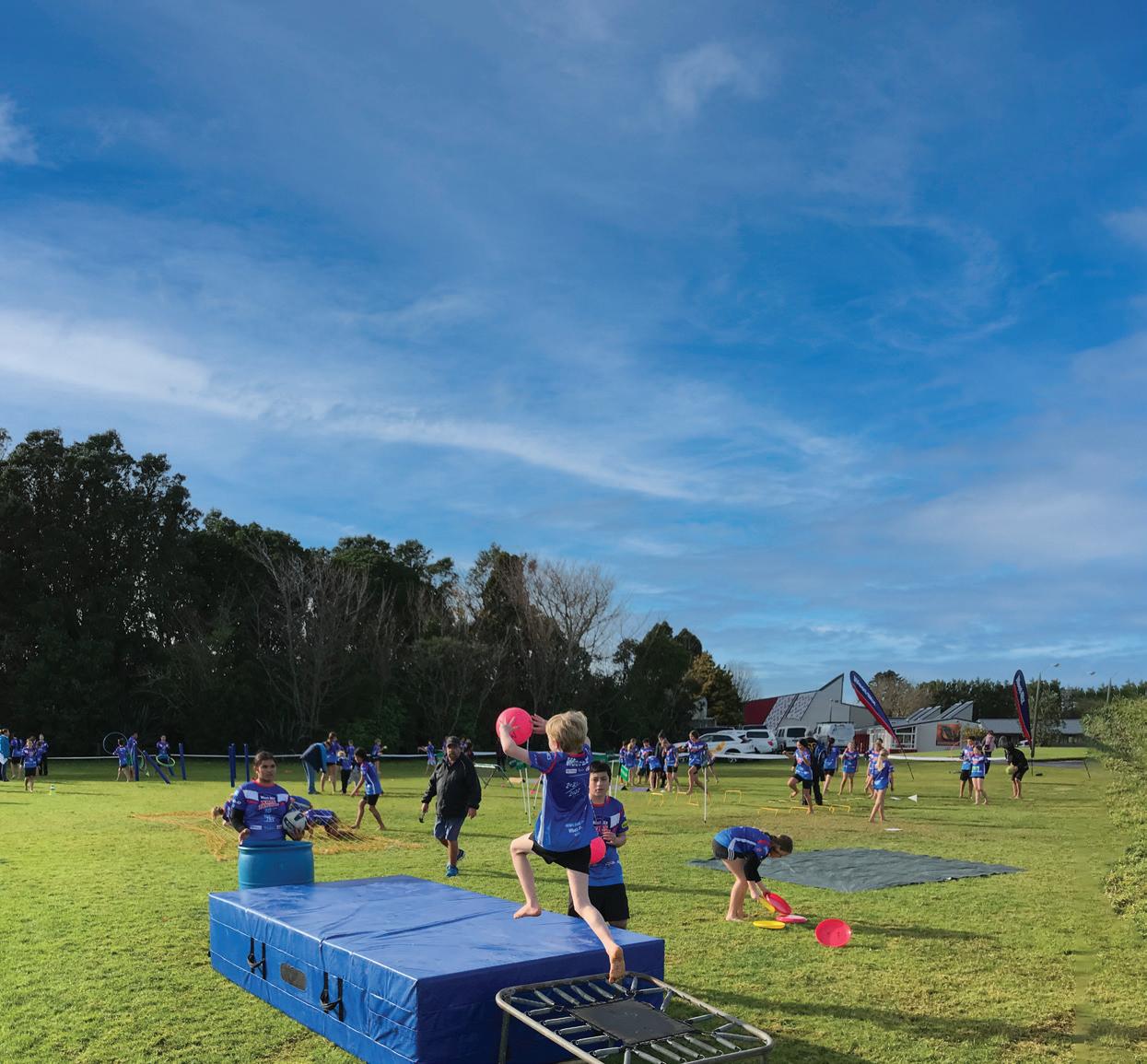
The support of the Healthy Active Learning team at Sport Taranaki is showing that when teachers and school leaders are given the guidance, time, and space to explore health and physical education, they understand its intention: to improve the wellbeing of the individual, other people, and wider society.
It is not uncommon for a school calendar in Aotearoa to consist of swimming sports, cross country, and athletics, with learning focused on ‘readying’ ākonga for these events and then identifying the top athletes to represent the school at the next stage.
Unfortunately, the time spent learning the associated physical skills required can sometimes result in ākonga sitting in a line waiting their turn, or simply doing laps around the field. Hardly a quality physical activity
experience for the participant, or non-participant if students turn up to school with a note to excuse them from the experience altogether.
Keeping this in mind, the wero is set. How do we cater for all? How do we make sure we are being inclusive of all abilities? How do we instill a lifelong love of learning and moving within our tamariki for the purpose of wellbeing? How do we create quality experiences where ākonga are challenged within a safe environment?
Ākonga at the centre
For Westown School health and physical education lead Paul Tattersall, putting students at the centre was key to change.
As a result of attending Healthy Active Learning
46 Education Gazette gazette.education.govt.nz
Manukorihi Intermediate students enjoying tabloid style activities in-between the Weetbix TRY-Challenge event.
workshops and receiving follow-up support, Paul had a real “flip in mindset” and saw an “opportunity to get creative in offering a different experience”.
Paul started by asking students for their views on cross country in its current state – an event in which 40 percent of the school did not participate.
Empowering his student leaders through a tuakana teina approach, ākonga designed activities which aimed to engage the whole school community.
The event saw multilevel school groups taken through a range of activity stations, moving alongside whānau to the musical beats delivered by teacher aide DJ, while local police cooked on the barbecue, culminating in a flurry of coloured powder through the final channel.
Meanwhile, at Huirangi School, events continue to grow and develop in response to student wants, needs, and experiences.
After seeing how small-sided games led to higher participation and enjoyment, junior teacher Danita Drinkwater immediately introduced a number of these games as part of the school’s traditional athletics day rotations.
On event day, Danita knew they were onto something good. Previously ākonga would have lined up behind the long jump pit for one of their three turns. They were now moving, jumping, and laughing.
Fast forward to the following year, senior teacher Ana Southee thought her students could have a role in creating an inclusive, student-led event.
Using Strand D: Healthy Communities and Environments to guide the learning, and specifically, the Achievement Objective; Plan and implement a programme to enhance an identified social or physical aspect of their classroom or school environment, the Year 5 and 6 students designed games and activities with a ‘run, jump, throw’ focus.
They trialed them first with the junior students as part of their learning programmes, before refining them to then implement on the day.
“It couldn’t have gone better. The senior students did such a great job planning and then running the event. We will be re-thinking all our school events from now,” says Ana.
A change of thinking
Student input was also a successful ingredient for Manukorihi Intermediate in shaping a Sanitarium TRYChallenge event as the host school.
Student leaders saw it as an opportunity to provide the intermediate’s contributing schools with a ‘taste of Manukorihi’.
Whilst SMC Events provided the bells and whistles with their inflatable obstacle course, students designed additional ‘tough kid’ style aspects of the course, while tabloid activities were run by community icon Kevin Bennett as part of a huge community event with a meaningful purpose.
Principal Fiona Low said the success of the event had inspired a Colour Run the following term.
“It was awesome to see students who are usually less enthusiastic about participating in physical activity absolutely giving it their all, doing as many laps of the course as they could, being active and having fun.”
For other schools across the region, further exposure to the curriculum has led to a change of thinking and design of learning programmes within health and physical education.
Some are realising the impact that movement activities, using the same pedagogical strategies they use across other learning areas, can have on engagement and are moving away from simply ‘readying’ their students for the events.
They are being more responsive to the strengths and needs of ākonga by utilising the full breadth and depth of the curriculum and looking for opportunities to learn ‘through movement’.
While traditional events can provide an opportunity for a select few to shine, the whakataukī gifted to the learning area of health and physical education, ‘He oranga ngākau, he pikinga waiora – Positive feelings in your heart will enhance your sense of self-worth’, is a fantastic reminder that every learner should be able to find their sense of belonging and self-worth.
Healthy Active Learning
Healthy Active Learning is a joint initiative between Sport NZ, the Ministry of Health, Te Whatu Ora | Health New Zealand, and the Ministry of Education to improve the wellbeing of tamariki and rangatahi through healthy eating and drinking and quality physical activity.
To deliver its component Sport NZ has partnered with Regional Sports Trusts, including Sport Taranaki, to provide schools with a physical activity workforce. Currently over 900 schools and kura across the motu are being supported through this locally led approach to create healthy and active learning environments and better connections to their local communities.
Read more at sportnz.org.nz/get-active
47 Tukutuku Kōrero
28 August 2023
“The senior students did such a great job planning and then running the event. We will be re-thinking all our school events from now.”
Ana Southee

“It was awesome to see students who are usually less enthusiastic about participating in physical activity absolutely giving it their all, doing as many laps of the course as they could, being active and having fun.”
48 Education Gazette gazette.education.govt.nz
Fiona Low
A tuakana-teina approach was key to a successful modified Athletics Day for Huirangi School.
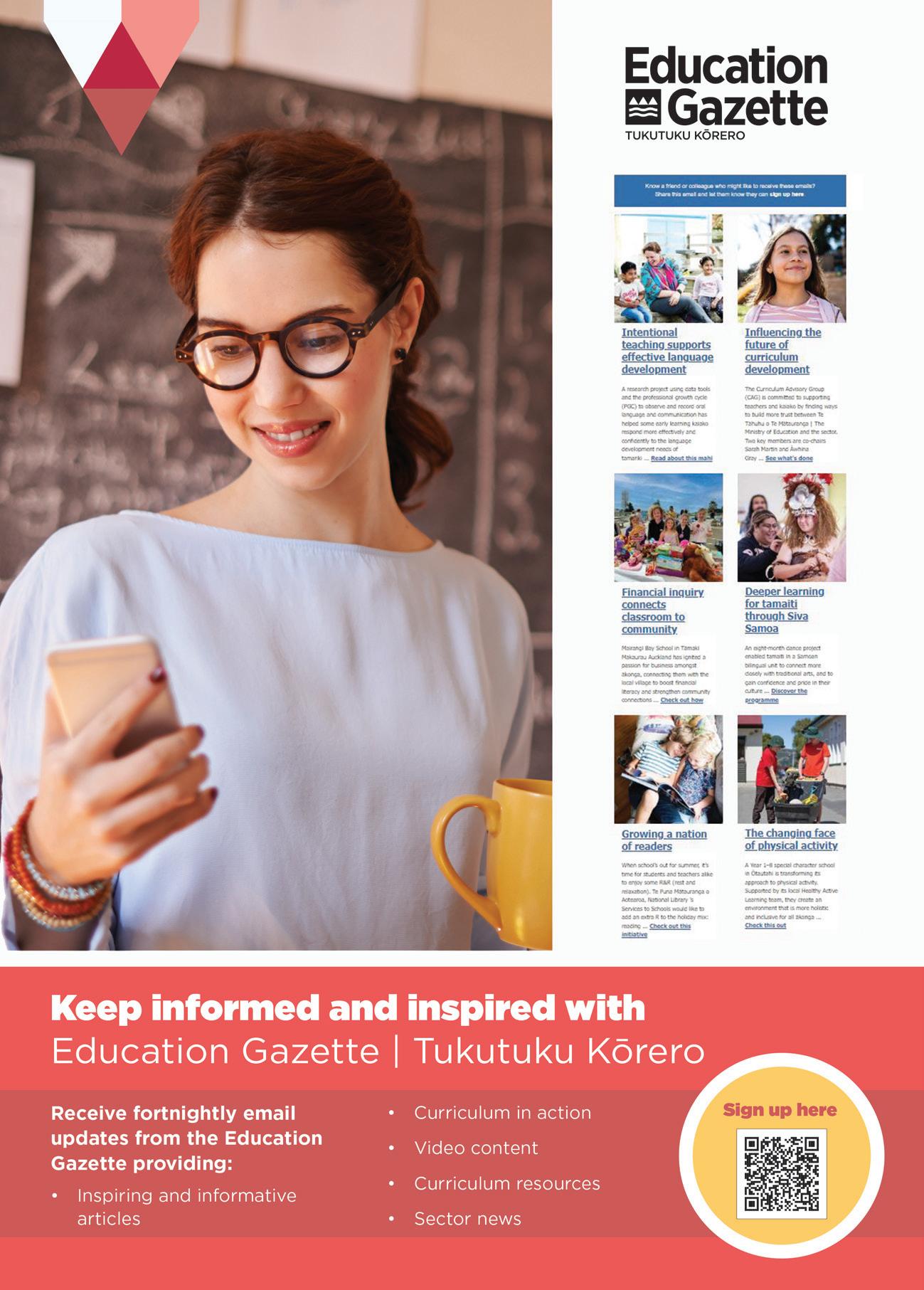
Maths Teachers
and End of
SINCOS Mission Statement: Reducing Teacher Workload
Boutique
Tuition
Ph 0210 8914083
Email: Michael.clarke@nzbs.net.nz
EDUCATION BEYOND THE CLASSROOM
Get your class to submit a 200-word article, with photos, describing their best school trip to be in the draw to win $250 for your school.
The best entries will be printed in Education Beyond the Classroom, distributed to schools on 9 October
Entries close 6 September.
Email entries to: jill.parker@nzme.co.nz
Independent centre on the market for the first time in 23 years
• Established by current retiring owner with an impressive record of continual growth in turnover and profit.
• The current owner will stay on for a set time during the ownership transition.
• Caters to primary and secondary school students.
• Excellent relationships and reputation with surrounding schools.
• Fully staffed with specialist tutors Can be run as an owner operator and/or a managed business.
• Perfect opportunity for a qualified teacher
• Located in a high growth area of Central Auckland.
• Flexible hours that create a work/life balance
Do you have a vacancy that you would like to advertise to the education sector?
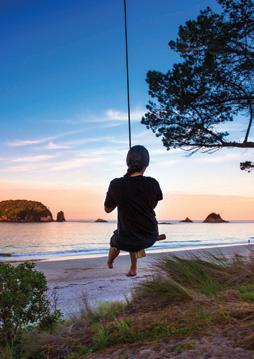
50 Education Gazette gazette.education.govt.nz NOTICEBOARD
Centre
• Price on Application. Profitable!
for Sale Highly
For further information contact Michael Clarke, Registered Agent REAA 2008.
Reduce Workload and Stress (Years 11-13) Use our Editable Assessment Masters, Internal
Year.
www.sincos.co.nz
an advertisement in the vacancies section and reach both the passive and active jobseekers by contacting Jill Parker:
To view the PLD, general notice listings and vacancies at gazette.education.govt.nz Scan the QR codes with the camera on your device. VACANCIES NOTICES PLD
Best School Trip Competition
Place
jill.parker@nzme.co.nz 027 212 9277
Tumuaki/Principal Springlands School
• Are you a visionary leader with passion and purpose at the heart of what you do?
• We have an extraordinary opportunity to build on our kura’s success.
• Make your mark with our future generations, in this inspiring community role based in arguably one of NZ’s most beautiful lifestyle locations!
Established in 1886, Springlands School is located on the western side of Blenheim, in beautiful, sunny Marlborough. Our current role is 370+ from years 0-6. Springlands School is a part of a supportive and diverse community. We have always been held in very high regard as a successful, cutting-edge school and strive to make a difference by developing lifelong learners.
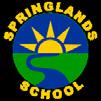
Mā Te Mahi Ka Ora
As principal, you'll lead our school, ensuring everyone achieves success through building strong connections, continuing and extending our cutting-edge programmes, but above all else, you will develop an exceptional school culture where everyone thrives. We are strongly committed to culturally responsive practices and Te Tiriti o Waitangi, our new principal will help deepen this further.
Our people want a community minded, inclusive leader who is a strong communicator. A leader who embraces people’s strengths, balances student and staff needs, while empowering their growth. Someone with real mana who can have fun, get involved and lead us into the future.
Trident High School is a co-educational secondary school looking leader who will continue to build on the successes and reputation opportunity to bring your collaborative leadership experience, your educational achievement and your proven leadership practices to school operates as part of the Whakatāne Kahui Ako.
Whakatāne is in the the heart of the Eastern Bay of Plenty. Whakatane diversely beautiful areas in New Zealand. It sits on a natural harbour which gives access to the outdoors with surfing, mountain biking, tramping, at your doorstep.
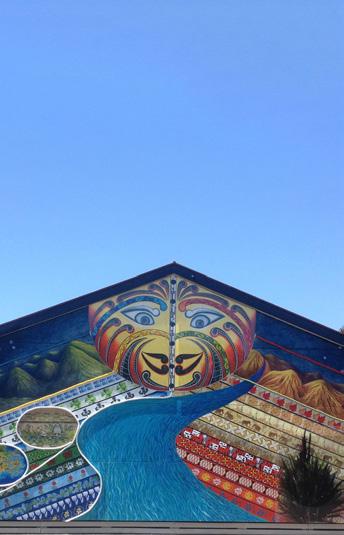
As Tumuaki you will be passionate about our ākonga and place them making.
You will be a strong leader with a vision of what education means to ākonga and which sits with the school values of Respect, Quality You will be committed to fostering the professional growth of our staff in facilitating the success of our ākonga.
You will be responsive to culturally connecting with our whānau You will be a confident and bold leader with exceptional commun integrity.
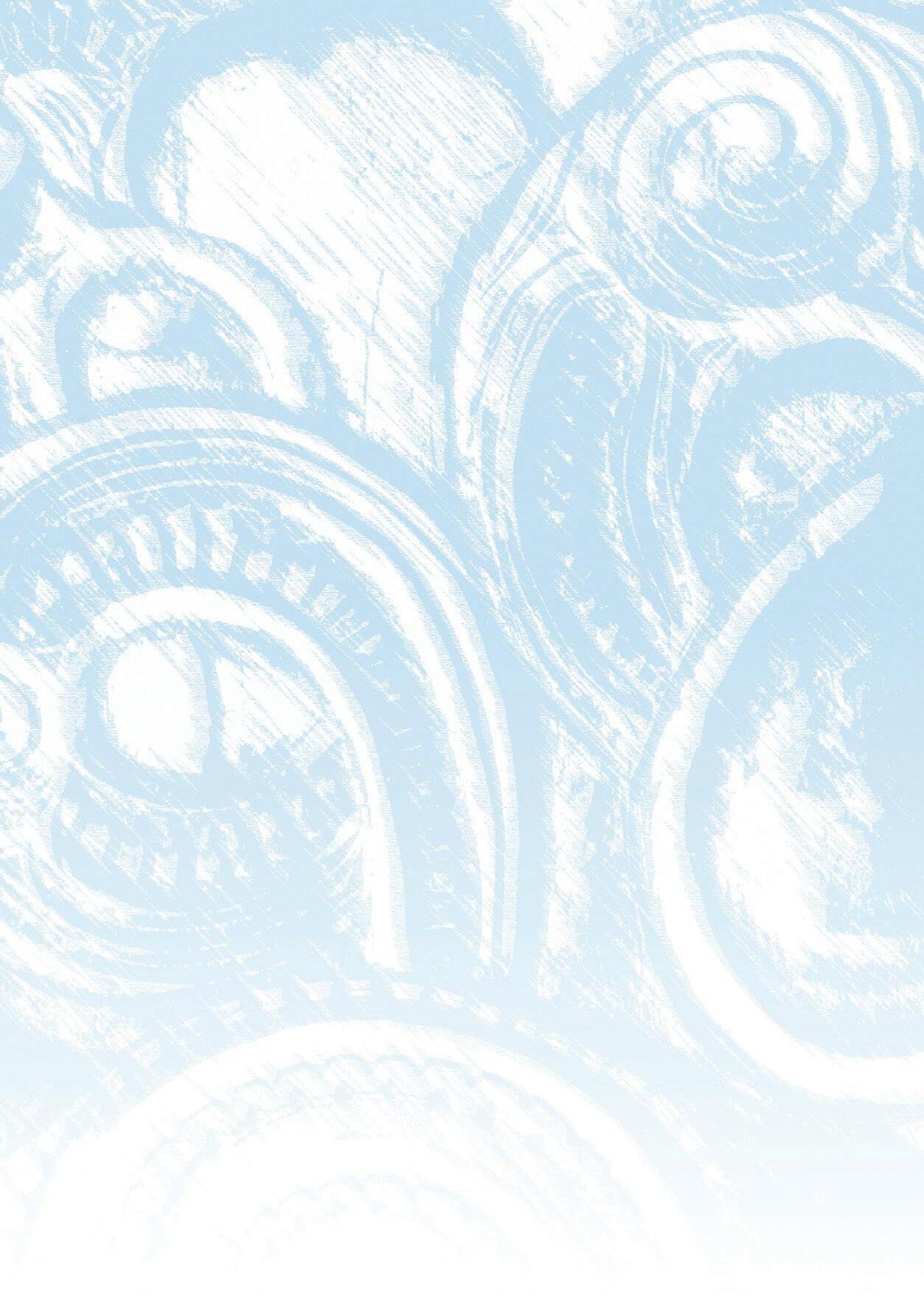
You will be visible, present and accessible to our students,
For more information on our school: trident.school.nz
Application packs are available by emailing: pa@trident.school.nz
Applications close: 9.00am Friday 6 October, 2023
Kia Manawa Nui
Tumuaki | Principal TRIDENT HIGH SCHOOL
address your covering letter and CV, along with your application form to our recruitment consultant,
McAlpine, 021 220 5832, alisonmmcalpine@gmail.com Closing Date for Applications is Monday 11th September
Te Kura o te Puna Wai Whenua Blenheim, Marlborough
Please
Alison
Applications close: 5:30pm on Wednesday
6 September 2023
Scots College is looking to appoint a new Principal of the Middle School, commencing January 2024. The Middle School has grown significantly, and we are seeking an experienced educational leader who is passionate about teaching, learning and the holistic development of young people. The appointee will be innovative and dynamic with the skills to collaborate with the College’s Headmaster and Junior/Senior school principals within the combined schools’ model the College operates under.
With a national and international reputation for excellence, Scots College is a world-class independent school with a strong Presbyterian heritage. It is a fully co-educational, IB World School in the Eastern suburbs of Wellington, New Zealand and comprises three schools in one; Junior (Years 1-6), Middle (Years 7-10) and Senior (Years 11-13). Our mission is to provide our students with an excellent and holistic education within a vibrant learning environment, our aim being to allow them to contribute as global citizens who think creatively, reason critically, communicate effectively and develop the necessary skills to Learn. For life.

Application details: Further information and a Candidate Pack is available at https://www.scotscollege.school.nz/about/careers

Kaikōura High School Tumuaki/Principal Vacancy
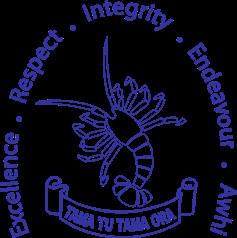
Mauri Ora Kaikōura Tuarua Kura Hapori
To learn more about our school and apply for this position, please visit: www.kaikourahigh.school.nz
Applications close on Sunday the 8th of October at 5pm
Kei te mihi mahana kia koe/Warmness of greetings to you, Kaikōura Kura Tuarua Hapori/the Board of Trustees and Kaikōura community seek a Tumuaki/Principal to lead Kaikōura Kura Tuarua/High School.
Much is invested in this role - the hopes and aspirations of whānau/families for Rangatahi. There is a genuine desire and hunger for a localised curriculum for local Rangatahi, together with a willingness from local businesses to support tatou kura/our school.
The potential is palpable: The beauty of the environment from Ki Uta ki Tai/the mountains to the sea, rich marine life and culture encapsulates the scope and breadth of the role. We seek someone who wants to belong to our hapori/ community, shares our wawata/aspirations and kimikimi/ imaginings whilst having the skillset to make it happen and deliver a quality mātauranga/education for all.
Education Gazette Publication dates 2023
52 Education Gazette gazette.education.govt.nz
Scots College,Wellington Principal Middle School
ISSUE EDITORIAL ADVERTISING BOOKING DEADLINE VACANCY BOOKING AND ALL ARTWORK DEADLINE BY 4PM PUBLICATION DATE 102.12 1 September 6 September 18 September 102.13 22 September 27 September 9 October 102.14 13 October 18 October 30 October 102.15 3 November 8 November 20 November 102.16 24 November 29 November 11 December
TAUTAPATIA TĀU
TINO ĀKONGA
MŌ TE TOHU KAIRANGI MĀTAURANGA AHUMAHINGA A
TE PIRIMIA.
Kia whakanui tātou i ngā ringa waihanga, ringa auaha, ringa rehe o anamata.
He paraihe e $2,000 te nui i whakaritea mō te tino tauira e whakaatu ana i te kairangitanga o te mātauranga ahumahi ki ia kura.
Kotahi te tauira Tau 12, Tau 13 rānei o ia kura e māraurau ana kia whakawhiwhia ki te Tohu.
Ka tuwhera ngā tautapatanga o 2023 hei te 17 o Hūrae, ka kati hei te 23 o Hepetema.
KA RIRO I NGĀ
KAIWHIWHI HE PARAIHE E $2,000 TE NUI
Mō ngā puka tautapa me ērā atu mōhiohio, toro atu ki: pmvea.education.govt.nz
Mō ngā pātai, tuku īmēra ki: vocational.excellence@education.govt.nz
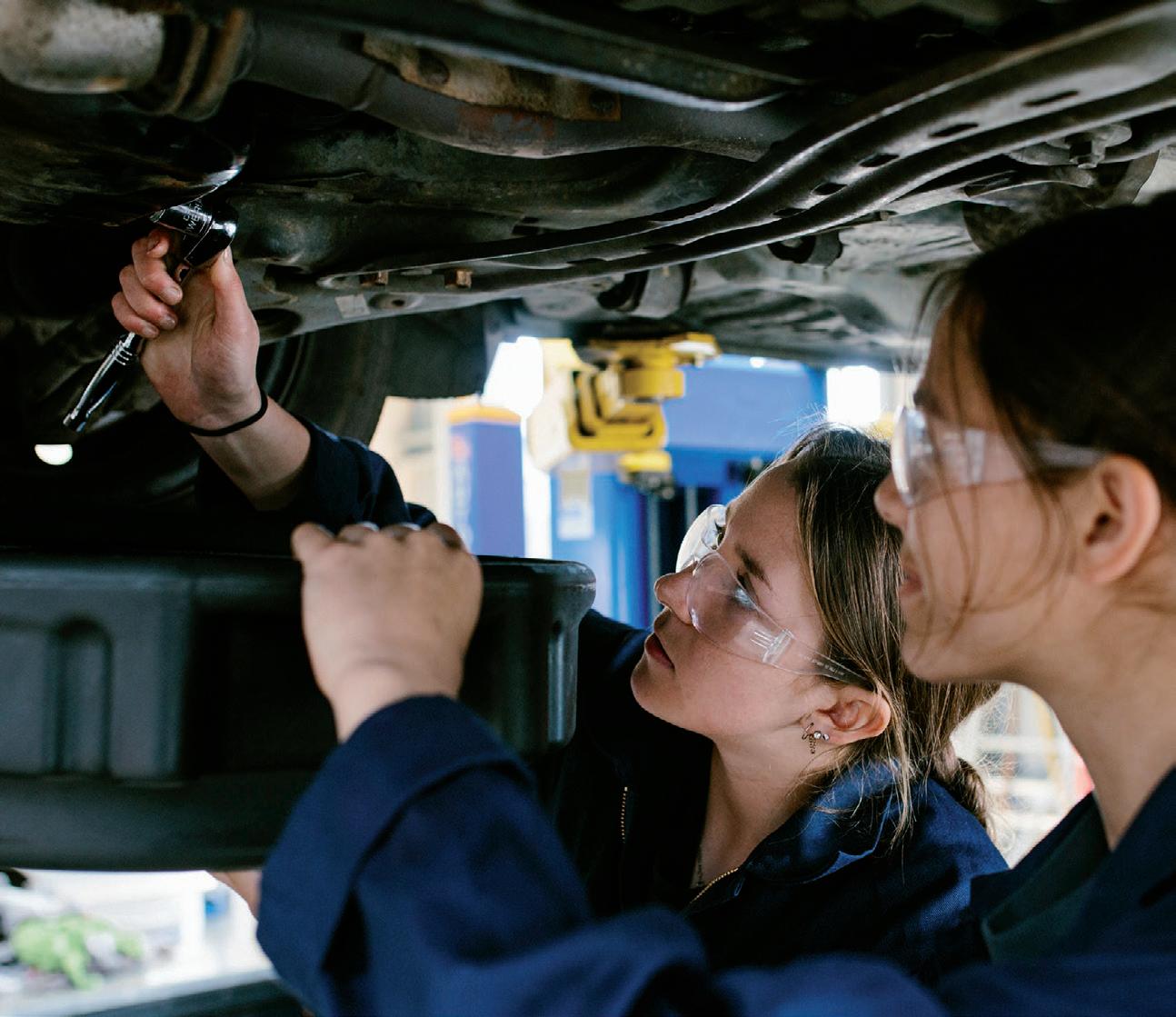
NOMINATE YOUR TOP STUDENT FOR THE PRIME MINISTER’S VOCATIONAL EXCELLENCE
AWARD.
Let’s celebrate our future creators, innovators, crafters and tradespeople. There’s a $2,000 cash prize for the top student who demonstrates vocational excellence at each school or wharekura.
One Year 12 or Year 13 student per school or wharekura is eligible to receive the Award.
Nominations for 2023 open on 17 July and close on 23 September.
RECIPIENTS RECEIVE A CASH PRIZE OF $2,000
For nomination forms and other information, go to: pmvea.education.govt.nz
For queries, email: vocational.excellence@education.govt.nz
























































 Camera, lights, action! Louis and Lam provide first-class customer service. The balloon animals were popular with all ages and sold out quickly.
Camera, lights, action! Louis and Lam provide first-class customer service. The balloon animals were popular with all ages and sold out quickly.
































